#Re-Launched: Science Fiction Stories of New Beginnings
Text
Stories from Sol: The Gun-Dog launches February 20, 2025 - Gematsu
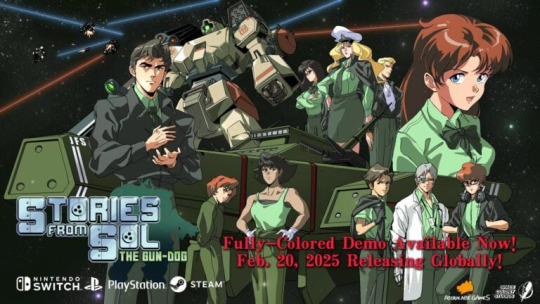
Science-fiction visual novel Stories from Sol: The Gun-Dog will launch for PlayStation 5, PlayStation 4, Switch, and PC via Steam on February 20, 2025, publisher Astrolabe Games and developer Space Colony Studios announced. It will feature English, French, Spanish, German, Japanese, Traditional Chinese, and Simplified Chinese language options.
The companies also unveiled the new “Full-Color Mode,” which makes the game playable in full color. An update for the previously released demo featuring this new mode is available now for PlayStation 5 and PC, and will launch for Switch on September 19.
As previously announced, PM Studios and Meridiem Games will publish physical editions of Stories from Sol: The-Gun Dog in North America and Europe, respectively. The physical edition will be available for PlayStation 5 in North America, and for PlayStation 5 and Switch in Europe.
Here is an overview of the game, via Astrolabe Games:
About
War is over. War is just beginning.
Planetary Calendar 214. Four years have passed since the end of the Solar War. Our protagonist, scarred from the loss of his crewmates in the war, is re-assigned to the Jovian patrol ship Gun-Dog as it’s dispatched with orders to investigate mysterious signals coming from the edge of Jovian Space.
Unknown to the Gun-Dog’s crew, a new danger looms deep in the ocean of stars, threatening not just the Gun-Dog but all her crew.
Take on the role of the Gun-Dog’s security officer as you attempt to save the ship from an unknown assailant whilst navigating the paranoia, conspiracies and vendettas that break out amongst the crew. As camaraderie falls apart can you overcome the challenges that await?
The Game: A Love Letter to Retro Anime and 80s Science-Fiction
Stories from Sol: The Gun-Dog is a visual novel adventure in the spirit of classic PC-9800 titles. Featuring a vintage green screen aesthetic, Space Colony Studios strives to create an “era-accurate” game that exudes retro vibes in every way, from the text to the visual effects. As the Jovian patrol ship sails into the darkness among the stars, the players will feel like they are on an adventure in an 80s Sci-Fi as they solve the mystery they find themselves in.
The Story: A New Threat Emerges From the Void
Humans have long since freed themselves from the grasp of gravity, but they are still unable to escape the hold of war.
It’s year 214 of the Planetary Calendar. Four years have passed since the end of the Solar War and an uneasy peace persists throughout the solar system. The Jovian patrol ship Gun-Dog is sent on a reconnaissance mission to investigate mysterious signals coming from the edge of Jovian space. What starts as a routine assignment quickly escalates into a battle for survival as an unknown threat terrorises the crew.
The Gameplay: Investigate. Interact. Analyze. Advance.
Utilizing traditional point-and-click adventure mechanics, during your time on the Gun-Dog, you can navigate various locations on the ship, examine the details of the richly realized backgrounds or talk with the different crew members on board. You will need to listen closely to the characters’ words to reveal important clues or duplicitous intentions and keep your eyes peeled for key items and interactive elements in the backgrounds that you can use to advance the story.
The Characters: Get on Board With the Crew of the Gun-Dog!
All stories are about people and the cast of The Gun-Dog bring the story to life, so much so that their charm and charisma convinced the team at Astrolabe Games to board the Gun-Dog and sign up to be the publisher. From the elegant yet distant Captain Bartermews, to the bubbly Lieutenant Commander Cassandra Quinn, to the assertive and domineering Chief Mackenzie Cathays, The Gun-Dog features an extensive cast of characters for you to meet. Each crew member has a distinct personality, role and history. Get to know them and their quirks and decide whether to work with or against them to unravel the mystery that lies at the story’s heart.
The Place: Adventure in an Entirely Explorable Ship!
The main stage of the first installment in the Stories from Sol series, as the Jovian patrol ship Gun-Dog heads into deep space it serves as the setting for the game’s story. It has been exhaustively realized. Rich and evocative descriptions of the ship, including the constant rumble of the engine room, the bustle of the bridge, the silence of space pair with an extensive range of scenes that have been meticulously designed and animated in detail to deliver an immersive experience. Inspired by the best that anime has to offer the ship even features “Armored Frames,” mechanized, human shaped, weapons of war.
Watch a new trailer below. View a new set of screenshots at the gallery.
Release Date and Full-Color Mode Trailer
youtube
#Stories from Sol: The Gun-Dog#Stories from Sol#Astrolabe Games#Space Colony Studios#visual novel#Gematsu#Youtube
17 notes
·
View notes
Text
DINNER FOR TWELVE
October 14, 1950

“Dinner for Twelve” (aka “Liz Cooks Dinner for Twelve”) is episode #101 [some sources say #100] of the radio series MY FAVORITE HUSBAND broadcast on October 14, 1950.
This was the sixth episode of the third season of MY FAVORITE HUSBAND. There were 31 new episodes, with the season ending on March 31, 1951.
vimeo
This episode was fully animated and can be found on Vimeo. It was created by Wayne Wilson in 2012.
Synopsis ~ George has invited ten dinner guests on the maid’s day off and Liz is determined to prove to George's mother that she can prepare a dinner for twelve without any help.

“My Favorite Husband” was based on the novels Mr. and Mrs. Cugat, the Record of a Happy Marriage (1940) and Outside Eden (1945) by Isabel Scott Rorick, which had previously been adapted into the film Are Husbands Necessary? (1942). “My Favorite Husband” was first broadcast as a one-time special on July 5, 1948. Lucille Ball and Lee Bowman played the characters of Liz and George Cugat, and a positive response to this broadcast convinced CBS to launch “My Favorite Husband” as a series. Bowman was not available Richard Denning was cast as George. On January 7, 1949, confusion with bandleader Xavier Cugat prompted a name change to Cooper. On this same episode Jell-O became its sponsor. A total of 124 episodes of the program aired from July 23, 1948 through March 31, 1951. After about ten episodes had been written, writers Fox and Davenport departed and three new writers took over – Bob Carroll, Jr., Madelyn Pugh, and head writer/producer Jess Oppenheimer. In March 1949 Gale Gordon took over the existing role of George’s boss, Rudolph Atterbury, and Bea Benaderet was added as his wife, Iris. CBS brought “My Favorite Husband” to television in 1953, starring Joan Caulfield and Barry Nelson as Liz and George Cooper. The television version ran two-and-a-half seasons, from September 1953 through December 1955, running concurrently with “I Love Lucy.” It was produced live at CBS Television City for most of its run, until switching to film for a truncated third season filmed (ironically) at Desilu and recasting Liz Cooper with Vanessa Brown.
MAIN CAST

Lucille Ball (Liz Cooper) was born on August 6, 1911 in Jamestown, New York. She began her screen career in 1933 and was known in Hollywood as ‘Queen of the B’s’ due to her many appearances in ‘B’ movies. With Richard Denning, she starred in a radio program titled “My Favorite Husband” which eventually led to the creation of “I Love Lucy,” a television situation comedy in which she co-starred with her real-life husband, Latin bandleader Desi Arnaz. The program was phenomenally successful, allowing the couple to purchase what was once RKO Studios, re-naming it Desilu. When the show ended in 1960 (in an hour-long format known as “The Lucy-Desi Comedy Hour”) so did Lucy and Desi’s marriage. In 1962, hoping to keep Desilu financially solvent, Lucy returned to the sitcom format with “The Lucy Show,” which lasted six seasons. She followed that with a similar sitcom “Here’s Lucy” co-starring with her real-life children, Lucie and Desi Jr., as well as Gale Gordon, who had joined the cast of “The Lucy Show” during season two. Before her death in 1989, Lucy made one more attempt at a sitcom with “Life With Lucy,” also with Gordon.
Richard Denning (George Cooper) was born Louis Albert Heindrich Denninger Jr., in Poughkeepsie, New York. When he was 18 months old, his family moved to Los Angeles. Plans called for him to take over his father’s garment manufacturing business, but he developed an interest in acting. Denning enlisted in the US Navy during World War II. He is best known for his roles in various science fiction and horror films of the 1950s. Although he teamed with Lucille Ball on radio in “My Favorite Husband,” the two never acted together on screen. While “I Love Lucy” was on the air, he was seen on another CBS TV series, “Mr. & Mrs. North.” From 1968 to 1980 he played the Governor on “Hawaii 5-0″, his final role. He died in 1998 at age 84.
Bea Benadaret (Iris Atterbury) was considered the front-runner to be cast as Ethel Mertz but when “I Love Lucy” was ready to start production she was already playing a similar role on TV’s “The George Burns and Gracie Allen Show” so Vivian Vance was cast instead. On “I Love Lucy” she was cast as Lucy Ricardo’s spinster neighbor, Miss Lewis, in “Lucy Plays Cupid” (ILL S1;E15) in early 1952. Later, she was a success in her own show, “Petticoat Junction” as Shady Rest Hotel proprietress Kate Bradley. She starred in the series until her death in 1968.
Ruth Perrott (Katie, the Maid) was also later seen on “I Love Lucy.” She first played Mrs. Pomerantz, a member of the surprise investigating committee for the Society Matrons League in “Pioneer Women” (ILL S1;E25), as one of the member of the Wednesday Afternoon Fine Arts League in “Lucy and Ethel Buy the Same Dress” (ILL S3;E3), and also played a nurse when “Lucy Goes to the Hospital” (ILL S2;E16). She died in 1996 at the age of 96.
Bob LeMond (Announcer) also served as the announcer for the pilot episode of “I Love Lucy”. When the long-lost pilot was finally discovered in 1990, a few moments of the opening narration were damaged and lost, so LeMond – fifty years later – recreated the narration for the CBS special and subsequent DVD release.
Gale Gordon (Rudolph Atterbury, George’s boss and Iris’s husband) does not appear in this episode, although the character is mentioned.
GUEST CAST
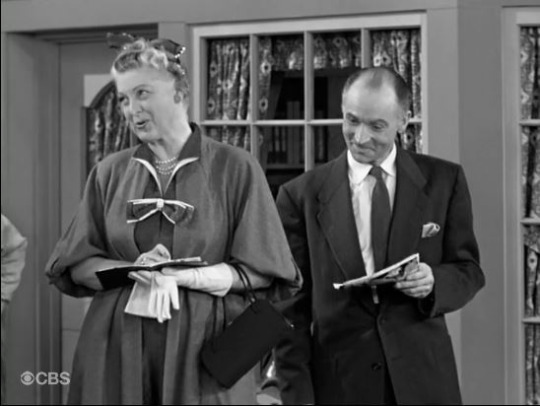
Eleanor Audley (Leaticia Cooper, George’s Mother) previously played this character in “George is Messy” on June 14, 1950. She would later play Eleanor Spalding, owner of the Westport home the Ricardos buy in “Lucy Wants To Move to the Country” (ILL S6;E15) in 1957, as well as one of the Garden Club judges in “Lucy Raises Tulips” (ILL S6;E26).
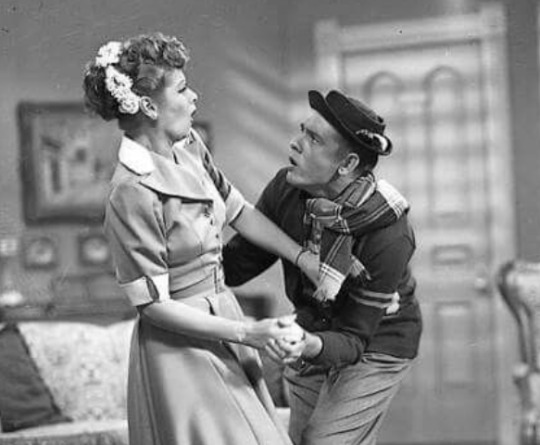
Richard Crenna (Delivery Boy) would make his television debut with Lucille Ball as Arthur Morton in “The Young Fans” (ILL S1;E20). The character is virtually a carbon copy of Walter Denton, the role he played for four years on radio’s “Our Miss Brooks” starring Eve Arden. In 1952, Desilu brought the show to television where Crenna recreated his role. He later starred in Desilu’s “The Real McCoys.” He would become one of Hollywood’s busiest actors, starring in "Vega$” and Sylvester Stallone’s Rambo films. He died in 2003.
THE EPISODE

ANNOUNCER: “In a little white two-story house located at 321 Bundy Drive in the bustling little suburb of Sheridan Falls, George Cooper is just leaving for the bank.”
Before leaving for work, George breaks the news to Liz that his mother is coming to dinner that night.
At the dinner table that evening, Mother Cooper (Eleanor Audley) is reminding her son to eat his spinach, thinking Liz is not feeding him properly. George suddenly remembers that he’s invited the Atterbury’s and some out-of-town clients to dinner on Monday night - dinner for twelve. The only problem is, Katie is going away on vacation on Sunday, so Mother Cooper suggest Liz cook the dinner herself.
Liz brags that she made the soufflé herself. Mother Cooper insists that Liz give her the recipe - right now!
LIZ: “Well, you just put all the cheese and things in a bowl. They you take a piece of ‘souff’ and put it on the top.”
Liz vows to cook dinner Monday night - all on her own. Monday morning, Liz cooks breakfast for George. The eggs are stone cold. Liz says she cooked them the night before and froze them to save time.

In “Lucy’s Schedule” (ILL S1;E31), to save time, Lucy prepares Ricky’s breakfast the night before and freezes it. She serves him frozen fried egg, exactly what Liz served George two years earlier!
Liz has invited Iris Atterbury over to help her cook the dinner for twelve. George leaves for work and the women repair to the kitchen to get a start on dinner. When Liz says she’s decided on chicken as the main course, Iris wonders assumes it will be broiled chicken.
LIZ (indignant): “Please! Does Oscar of the Waldorf serve broiled chicken? We are having poulet almondine.”

Oscar Tschirky (1866-1950) was a Swiss-American restaurateur who was maître d'hôtel of Delmonico's Restaurant and subsequently the Waldorf-Astoria Hotel in Manhattan, New York, United States. He was widely known as "Oscar of the Waldorf" and published a large cookbook. He is credited with having created the Waldorf salad, and for aiding in the popularization of the Thousand Island dressing. He died three weeks after this episode aired.
Liz realizes that she needs mushrooms but that she doesn’t have any in the house. She wonders whether she can use the mushrooms growing in the backyard. Iris points out that they may be toadstools, which are poisonous. Liz decides to use walnuts instead.
The girls peel onions for the dressing. They begin to tear-up from cutting the onions.
LIZ (tearfully): “This is the best time I’ve had in ages!”
IRIS (crying): “Me too!”
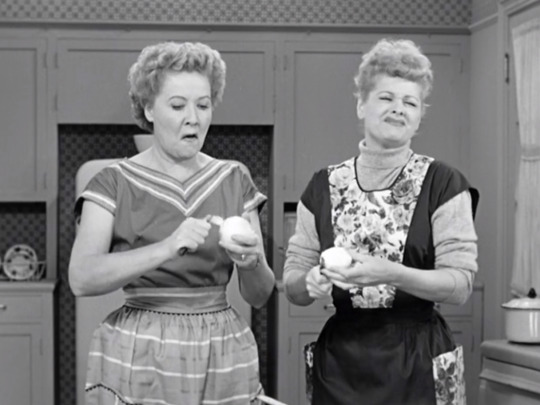
In “The Million Dollar Idea” (ILL S3;E13) in 1954, Lucy and Ethel were awash in tears when they peeled onions to make Aunt Martha’s Old Fashioned Salad Dressing.
ANNOUNCER: “As we return to the Cooper’s it’s several hours later and we find the kitchen knee deep in dirty saucepans, greasy skillets, broken eggshells, and well-thumbed cookbooks. Surveying the wreckage are Liz and Iris Atterbury.”
Iris wonders whether the chickens are ready to come out of the oven. Liz says she put them on at 9am at 600 degrees! Iris points out that they were only supposed to cook at 300 degrees.
LIZ: “I know but we have two chickens so I doubled it!”
IRIS: “I never would have thought of that.”
They open the over and find their two chickens have burned to a crisp and resemble “two little lumps of charcoal with legs and wings”! Just then, Mother Cooper arrives.
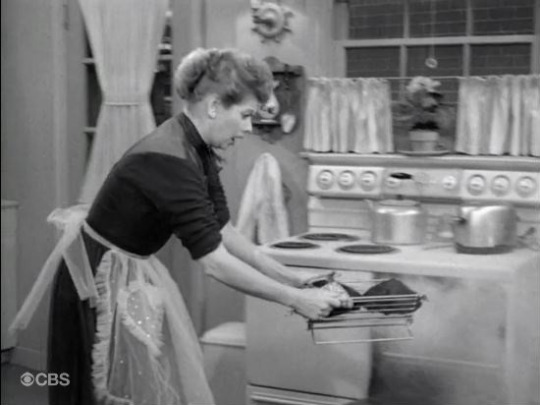
Lucy burned two chickens in “The Matchmaker” (ILL S4;E4) when preparing dinner for Sam (the spider) and Dorothy (the fly) a dating couple Lucy hopes to lure into matrimonial bliss.
Liz and Iris don’t tell Mother Cooper about the burned chickens. Chicken almandine is her favorite dish. She advises Liz on her cooking technique:
MOTHER: “You just keep your eye on them until they’re a nice crinkly brown.”
IRIS: “How about a nice crusty black?”
Mother Cooper discovers that Liz has burned the dinner. They trade insults and Mother storms out in a huff. Iris promises to help Liz cook a new dinner, but first she has to go to the beauty parlor to have her hair done.
When Iris gets home from the beauty parlor she phones Liz to see how the dinner is going. Liz is dazed and confused.
LIZ: “Iris, you are talking to a woman who’s gone through eight chickens today.”
Liz reports that the pressure cooker exploded and the chickens are still on the ceiling.
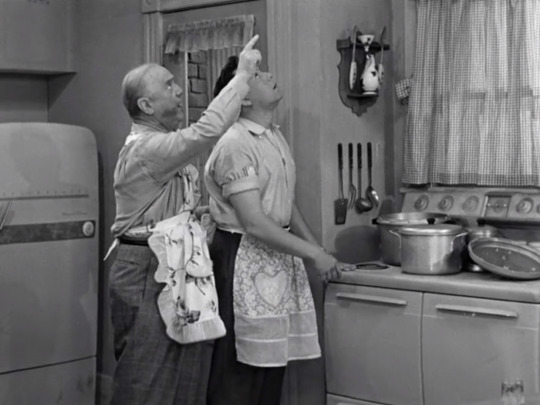
When Lucy and Ethel are working at the chocolate factory in “Job Switching” (ILL S2;E1), Ricky and Fred are cooking dinner at home. Ricky puts two chickens in the pressure cooker, which explodes and strands the birds on the ceiling!
Liz’s fifth and sixth birds were accidentally thrown in the garbage disposal. The seventh and eighth birds arrived from the butcher still alive! Iris asks Liz if she has cooked them yet.
LIZ: “Cook ‘em? I can’t even catch ‘em! When last seen, seven and eight were going east on Bundy Drive.”
IRIS: “You poor thing! Eight chickens and nothing to show for it!”
LIZ: “Oh, yes I have. Before she left seven laid an egg on the kitchen table.”

Iris tells Liz everything will be alright. Just then, a delivery boy from Johnson’s Catering Service (Dick Crenna) arrives at the Cooper’s back door with a meal for twelve: Roast prime ribs of beef, green beans, potatoes, and Yorkshire pudding. The meal was sent by Katie!
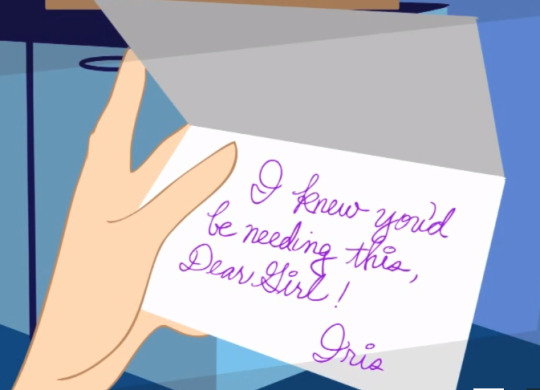
Just as she is about to call Katie to thank her, the Delivery Boy returns with another catered dinner: Lobster Thermidor with French fries and asparagus. This meal was sent over by Iris!
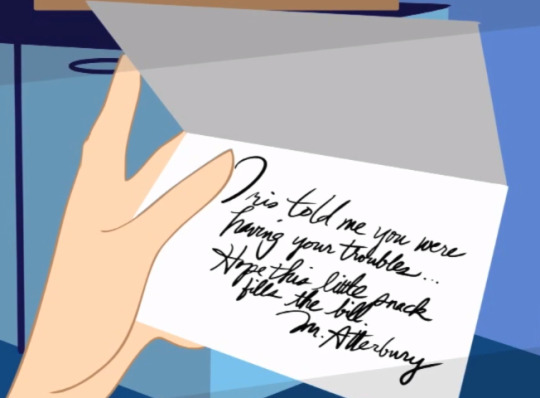
The Delivery Boy returns yet a third time! This time with Pheasant under Glass sent by Mr. Atterbury! Liz tips the boy with a bowl of Yorkshire pudding.
Oops! Yorkshire pudding is not served in a bowl. It is not a pudding in the American sense, but similar to pop-overs, designed to sop up the drippings and gravy when served with a roast beef.
The phone rings and it is Mother Cooper telling Liz that she has made a dinner for twelve and will bring it over. Liz says thanks but no thanks, and invites her to make the dinner party 13.
The phone rings once again - it is George. He has called to tell Liz that he has made a mistake. The dinner isn’t until next Monday night!
LIZ: “Oh, no!”
Announcer Bob LeMond reminds listeners that Lucille Ball can currently be seen in The Fuller Brush Girl and that they can read about her in the current issue of Pageant Magazine.
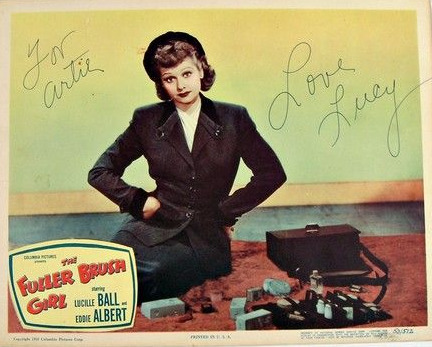

#Lucille Ball#My Favorite Husband#1950#Radio#Richard Denning#Bea Benadaret#Richard Crenna#Eleanor Audley#Bob LeMond#Ruth Perrott#I Love Lucy#The Fuller Brush Girl#Pageant Magazine#Oscar of the Waldorf#Oscar Tschirky
8 notes
·
View notes
Video
youtube
American Flagg! is an American comic book series created by writer-artist Howard Chaykin, published by First Comics from 1983 to 1989. A science fiction series and political satire, it was set in the U.S., particularly Chicago, Illinois, in the early 2030s. Writers besides Chaykin included Steven Grant, J.M. DeMatteis, Alan Moore and John Francis Moore.
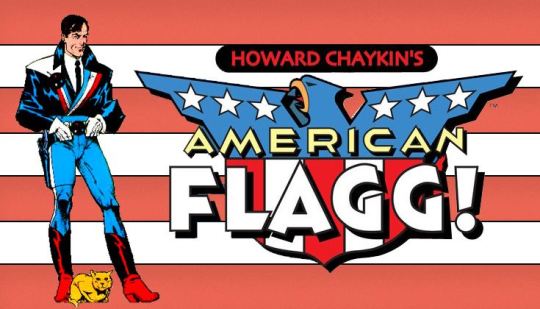
American Flagg, which ran 50 issues (October 1983 – March 1988), was one of the first titles to be published by First Comics, an early alternative press comics company founded in Evanston, Illinoisin 1983. Unusually for the time, the company offered its freelance writers and artists creator rights, including ownership of their creations. Regardless, writer-artist Howard Chaykin, then living in New York City, felt trepidation when First Comics approached him to do a project. He recalled in 2010,

My concern had all and everything to do with the fact that this was a brand new company, located in [a suburb of] Chicago. I'd always worked for companies I'd visited and had day-to-day-dealings with. [But] they talked about a financial plan that would make it possible for me to get out from under the debt I had accrued working for [publisher] Byron Preiss [illustrating early graphic novels]. It was encouraging, so I went home and concocted a scenario, a pitch document, and that was it.

Chaykin devised a series set in 2031, a high-tech but spiritually empty, consumerist world in which the American government has relocated to Mars, leaving what remains of the U.S. to be governed by the all-encompassing corporation known as the Plex. The series star is Reuben Flagg, a former TV star drafted into the Plexus Rangers and posted as a deputy in Chicago, Illinois.

The first 12 issues, running through cover-date September 1984, consisted of four interlocking, three-issue story arcs. Chaykin recalled his difficulty in producing 28 pages of art and script monthly. "I was still a smoker and a drinker at the time. And [the output was such that] I'd never done anything like that before, and it was insane. It just devoured my life [and] I had no assistants. I didn't know how to work with an assistant at that point, and it was a very difficult process. ... I was trying to do a fairly high-quality product and I didn't want to slough it off."

Chaykin made wide use of Craftint Duoshade illustration boards for American Flagg!, which in the period before computers, enabled him to add shaded textures to the finished art.Ken Bruzenak's lettering and logowork also won notice, as it was integral to American Flagg's futuristic, trademark-littered ambiance.

American Flagg's first dozen issues form one complete story that has influenced comic creators including Brian Michael Bendis and Warren Ellis. The comic made a huge splash at the 1984 Eagle Awards, the United Kingdom's pre-eminent comics awards. Chaykin and American Flagg! were nominated for ten awards, eventually winning seven. American Flagg! also won the 1983 Comics Buyer's Guide Fan Award for Favorite Comic Book and tied for the 1983 CBG Award for Favorite Character (Reuben Flagg).
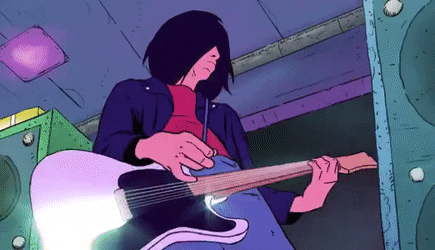
After issue #12, Chaykin continued the series while also working on such other projects as his revamp of The Shadow for DC Comics and the graphic novel Time2, based on characters introduced in a one-off American Flagg! special in 1986. During this time, Alan Moore wrote a back-up story that ran several issues and concluded in an issue-length story.
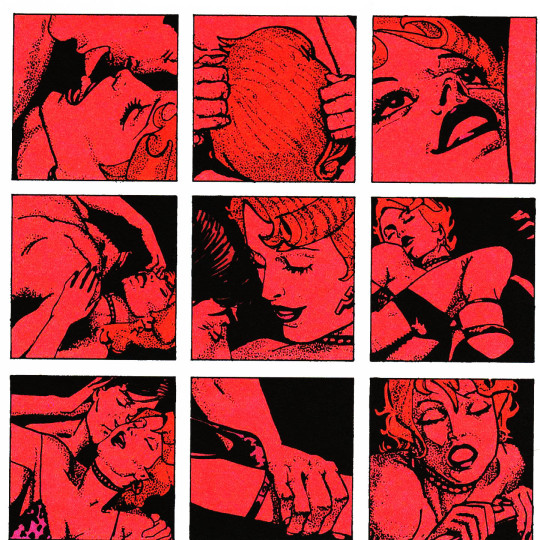
Eventually, Chaykin left, to be replaced on a regular basis by first Steven Grant then J.M. DeMatteis. Grant left after only seven issues due to creative friction with the series's new artist, Mark Badger. According to Grant, he had wanted to continue doing stories in the same style that Chaykin had established, while Badger wanted to take the series in new directions. Chaykin returned for a brief run to wrap up storylines before the first volume ended in March 1988. The title was relaunched a few months later as Howard Chaykin's Amerikan Flagg!. This run saw Chaykin return to write the first issue before handing over to John Francis Moore, with Mike Vosburg and Richard Ory penciling and inking the interior art, but the franchise failed to recapture its early success and was canceled after 12 issues.
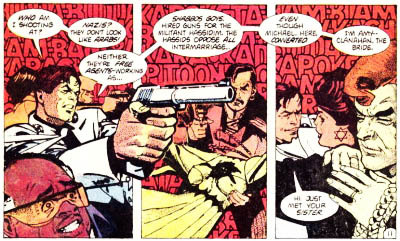
The story takes place in the year 2031, after a series of worldwide crises called the Year of the Domino (1996) has forced the U.S. government and the heads of major corporations to relocate to Hammarskjold Center, on Mars ("temporarily, of course"). In the wake of the American government leaving the planet and the Soviet Union collapsing from Islamic insurrections, there was a power shift throughout the world, with Brazilian Union of the Americas and the Pan-African League becoming the new superpowers on Earth.

However, the exiled American government, its corporate backers, and a group of technicians in the defected Soviet lunar colony of Gagaringrad form the Plex: a giant, interplanetary union of corporate and government concerns that conduct commerce and govern the United States from its capital on Mars. Many population centers are grouped around massive, fortified arcologies called Plexmalls and the law is enforced by the Plexus Rangers, the absentee Plex's Earthside militia.
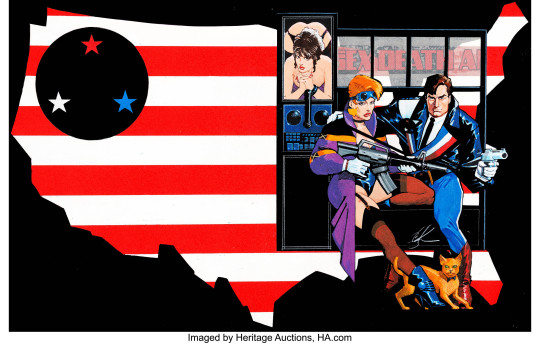
The Plex has formed the Tricentennial Recovery Committee, to get America "back on track for '76", but the TRC is in reality a plan to sell the United States off to the new superpowers and to leech off the remaining inhabitants before gaining true self-sufficiency. As a result, the Plex has outlawed non-combat related education, organized sports such as basketball and personal aircraft, restricted media to only one outlet, the Plex itself (although it has multiple channels), and advocates and glorifies the use of political violence amongst independent policlubs by providing money and firearms for its hit TV show Firefight All Night LIVE!, and covertly sterilizes the population by using a combination contraceptive and antibiotic called Mañanacillin to reduce the population.

This all changes when former television star Reuben Flagg is drafted and transferred to Chicago's Plexmall to replace the local Ranger Hilton "Hammerhead" Krieger's fallen partner. He witnesses widespread graft and corruption throughout the Plexmall, but also a series of subliminal messages implanted in a television show that are causing outbreaks of gang violence. After he uses his emergency powers to interrupt the broadcast, he not only ends the violence, but also brings forth a series of events that causes the Plex to send in covert agents, the death of Hilton, and the unveiling of Q-USA, a secret TV station owned and operated by Krieger that opens Flagg's eyes to the nature of the Plex.
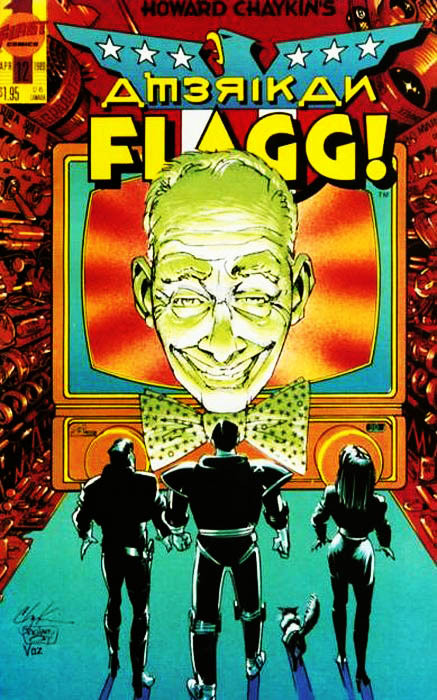
As the series progressed, Chaykin took less and less of a direct role in scripting and plotting the stories out, and by the third year of its run, he really had nothing to do with the book other than cover art. Stories began to violate the rules that Chaykin had explicitly stated in the writer's bible for the series (for instance, California was said to have slid into the Pacific Ocean, but in the final year of the book, California was merely shown to have been abandoned for reasons that were vague at best), and characterizations began to drift considerably as well. (Among other things, Flagg abandoned his interest in 1930s jazz, and was frequently shown listening to late-1960s rock, as well as becoming more of a traditional stern-jawed good-guy hero). After trying and failing several times to shore up declining interests, First Comics decided to lure Chaykin back into the writer's seat. "American Flagg!" wrapped up its principal storyline with issue #50. By this time, Reuben Flagg had traveled to Mars, overthrown the Plex, and become President of the United States. He then decided to separate Illinois from the United States and run it as his own personal fiefdom. All issues of this series took place in the year 2031.

The next year, the comic was re-launched under the name Howard Chaykin's Amerikan Flagg! (The "K" and a reversed "r" were to reflect the fact that most of this series took place in Russia) and picked up from where the earlier book had left off (in 2032). There is some difference of opinion as to whether this new book was intended to be a limited run, or open-ended as is the norm with comics. In either case, it ended after twelve issues. The final issue ends with a photo album of the Flagg's future domestic life, with lots of kids, a screaming shrew of a wife, and a balding, overweight Flagg.

Characters
Reuben Flagg, born in 2000 at Hammarskjold Center, Mars, to Axel and Rebecca Flagg, was a stand-up comic and popular television star of the show Mark Thrust, Sexus Ranger. After he was made superfluous by CGI technology, he joined the Plexus Rangers and emigrated to Earth, being stationed in the Chicago Plexmall. Flagg is Jewish, and his parents' "undesirably bohemian" attitudes have given him an idealistic view of the United States that runs contrary to the Plex. He has a desire to set things right again, and through inheriting Q-USA, begins to set on that path.
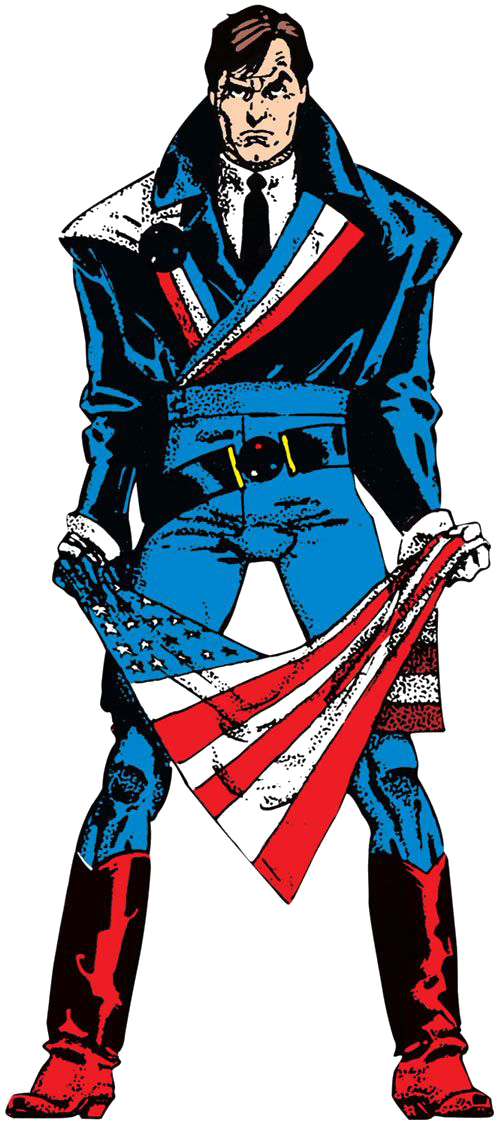
Raul the cat, an intelligent, talking orange tabby housecat. With the exception of his intelligence and his ability to speak (an ability whose origin is never explained), he appears to be otherwise a normal house pet. However, he has a customized set of cybernetic gloves, designed by Mandy Krieger, that give him opposable thumbs.
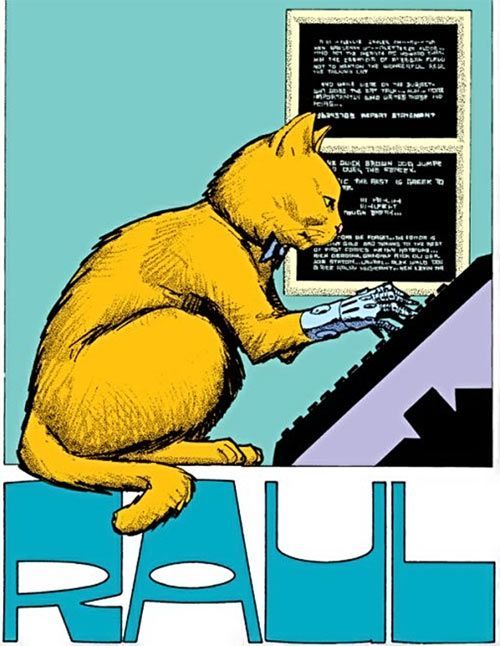
Hilton "Hammerhead" Krieger, was Flagg's superior at the Chicago Plexmall. A co-founder of the Genetic Warlords motorcycle gang along with Charles Blitz, but after his 13th arrest, the Plex drafts him because of his criminal experience. Intending to take advantage of the fledgling organization, he meets his future wife Peggy and stays with the Rangers. He does not trust anyone, not C.K., the mayor, not his wife Peg, not his daughter Mandy, and, while a Plexus Ranger, he especially does not trust the Plex. He runs an underground television station called Q-USA that broadcasts illegal sports, pornography, and pre-collapse movies and television shows. He is killed by a Plex secret agent, and his cat Raul gives Flagg the keys to the station. He also leaves behind a video explaining to his "heir" the truth of the Plex and the rules he wishes his successor to follow.

Amanda "Mandy" Krieger, daughter of Hilton, she is the air traffic controller for O'Hare Chicago Plexport. However, since the O'Hare Plexport only receives two flights a week, Mandy spends her time tinkering with electronics or getting into mischief. She later becomes a deputy to Flagg.
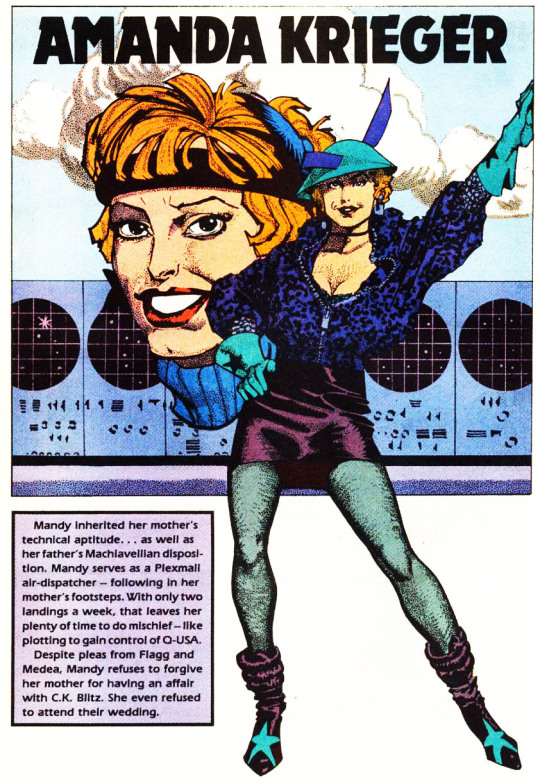
Jules "Deathwish" Folquet, captain of the Skokie Skullcrushers basketball team. Despite his punk appearance, his hulking size and the extreme nature of the sport he plays, Jules is quite intelligent. He is referred to as the "king of the two finger lobotomy." He first teams with Flagg to resolve a hostage crisis, but later forms the Video Rangers auxiliaries, and then becomes a Ranger deputy. He also later hosts a talk show with Raul called the "Him and It Show". In the second series, he renounces his violent ways, and, through a remarkable series of events, becomes Pope.
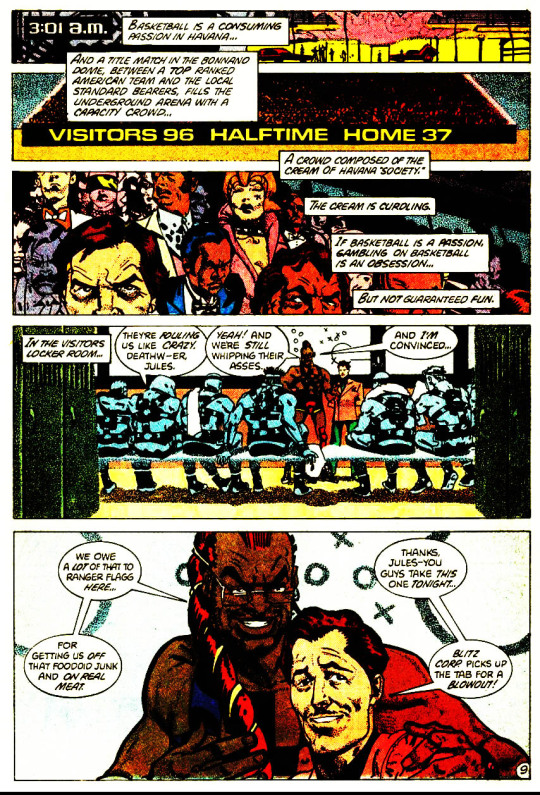
Charles Keenan Blitz, also known as The Honorable C.K. Blitz, a co-founder of the Genetic Warlords along with Hilton Krieger, also ended up getting drafted into the Plexus Rangers, but ended up leaving to become mayor of Chicago. Blitz has his hand in every deal, regardless of how illegal it may be; is extremely wealthy and corrupt; and has killed political opponents. As a side venture, he runs the Skokie Skullcrushers blackmarket basketball team. He is usually flanked by his two robot bodyguards, Bert and Ernie, named after "a private joke no one under 40 understands". He has had affairs with Mandy Krieger and with Peggy Krieger, while Hilton was fighting a brushfire war in Carracas, which lead to her being kicked out by Hilton and giving birth to...
Medea Blitz, the offspring of C.K. and Peggy. Early in the series, Medea is a wild child and hangs out with Cyril Farid-Khan, gang leader of current Genetic Warlords. She has a secret affair with Hilton Krieger, but after his murder, is considered a suspect and is involved in a traffic accident, which causes her to miscarry Krieger's child. In order to clean up her act, C.K. Blitz has her join the Plexus Rangers to straighten her out. As the series progresses, Medea is shown to become more and more accepting of the Rangers and becomes a decent team player in Flagg's group.
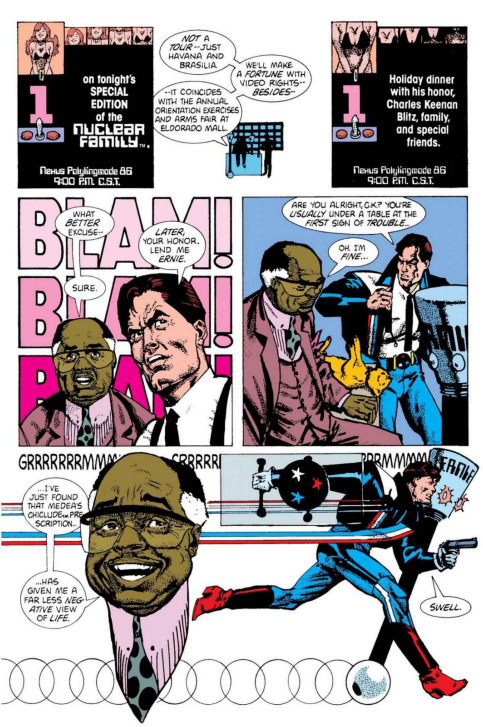
Sam Luis Obispo also known as Ned Beaumont, also known as Tom Slick. A hustler Reuben meets in Havana while escorting the Skokie Skullcrushers, he later partners with Flagg for most of his time in South America. He has an affair with the wealthy daughter of the Brazilian ambassador, which causes all sorts of problems for Flagg and himself.

William Windsor-Jones, but his best friends just call him Bill. Bill is the youngest member of the Witnesses, a gang of octogenarian rebels. He helps Flagg out from time to time, giving him intelligence and technical support. He later has become a newscaster for Q-USA. Bill is Prince William, and the rightful heir to the now-abolished British throne.
Luther Ironheart, a robotic Plexus Ranger with a head that consisted of a holographic projection. Assigned to be Reuben Flagg's partner on patrol. While not very bright, he exhibited superhuman strength and agility.
#american flagg#american flagg!#mark thrust#howard chaykin#dystopia#dystopian#1983#silversteel rocks#first comics#howard chaykin's american flagg#bob violence#mojo el diablo#comic tropes#overlord comics#strange brain parts#reuben flagg
7 notes
·
View notes
Text
The Moon, The Mantle, And A Mars-Sized Tragedy
Despite the fact that it is our planet's closest neighbor in Space, Earth's enormous Moon can shroud a considerable lot of its old insider facts very well as it does its charming, confusing move around our planet- - reflecting daylight like a mirror into the twilight sky over the Earth. Our Moon is a strange motivation for verse and fantasy, just as a long-standing representative wellspring of franticness. In any case, where did Earth's Moon originated from? The main hypothesis clarifying our Moon's old birth is known as the Giant Impact Hypothesis, which suggests that our Moon appeared as the consequence of a calamitous impact between the antiquated Earth and a meandering, not well featured Mars-sized protoplanet that cosmologists have named Theia. In September 2016, planetary researchers reported that their information affirm one specific situation that clarifies this heartbreaking impact previously, recommending that the moving Theia collided with Earth- - and pummeled it like a bowling ball hitting a watermelon.
About 4.56 billion years prior, when our infant Solar System was still during the time spent framing, Theia hit the proto-Earth and shot quite a bit of our newborn child planet to bits. Because of this terrible old crash, Earth's stones didn't only dissolve - they disintegrated! The components in those Earth rocks transformed into a gas similarly that bubbling water transforms into steam. At last, what survived from the first pre-crash Earth chilled, and it again framed a strong planet. What survived from the antiquated impact turned into the Moon.
This is the most recent translation of a decades-old hypothesis clarifying where Earth's lunar friend originated from, and it depends on ongoing estimations of components contained in both the Earth and its Moon. The planetary researchers suggest that their new estimations, which they have acquired of a component found inside both Earth and lunar rocks, presents a test to the main speculation of our Moon's puzzling roots. Incredibly little varieties in the isolation of the isotopes of potassium among Earth and Moon were shrouded like a lost fortune underneath the discovery furthest reaches of investigative methods as of not long ago.
Nonetheless, this changed in 2015 when Washington University in St. Louis (WUSTL) geochemist Dr. Kun Wang, at that point a Harvard Origins of Life Initiative Prize postdoctoral individual,CBD MoonRocks and Dr. Stein Jacobsen, teacher of geochemistry at Harvard University in Cambridge, Massachusetts, built up a procedure for examining these isotopes with a precisions multiple times superior to the best of every single past technique.
Dr. Wang and Dr. Jacobsen report in their new examination that isotopic contrasts among Earth and Moon rocks uncover the principal test proof that can segregate between the two driving situations clarifying lunar beginnings. As per the main situation, a low-vitality impact leaves afterward both a proto-Earth and Moon covered in a clouding silicate climate; in the second, a significantly more cataclysmic impact disintegrates Theia and the vast majority of the proto-Earth, extending to make a massive superfluid plate out of which Earth's Moon eventually shapes.
The new isotopic examination reinforces the case for a high-vitality situation, and it is distributed in the September 12, 2016 online release of the diary Nature. "Our outcomes give the primary hard proof that the effect truly did (to a great extent) disintegrate Earth," Dr. Wang remarked in a September 12, 2016 WUSTL Press Release. Dr. Wang is an associate educator of Earth and Planetary Sciences in the School of Arts and Sciences at WUSTL.
The Lunatic, The Lover, And The Poet
Earth's shimmering Moon balances suspended in the twilight night sky over our reality. In view of its incredible excellence and strange, gleaming evening time nature, Earth's Moon all through the ages has been the motivation for stories, legends, verse, and supernatural stories. It has likewise filled in as an antiquated image for that which is ladylike, just as for sentimental love and lunacy. Some society stories and youngsters' accounts notice the "Man in the Moon", on the grounds that - with a smidgen of creative mind - it would appear that a man's face has been carved on our lunar friend's far off surface. Different stories include a "Moon Rabbit". Dream and fiction aside, our Earth's dumbfounding Moon is an undeniable little world in its own right. Earth's Moon has been with us nearly from the very beginning, when our Sun and its combination of planets, moons, space rocks, and comets, were first shaping about 4.6 billion years back. It is likewise the main world past Earth that we have strolled after, deserting our impressions in the Moon-dust- - a quiet declaration murmuring that once we did exist, and that we had been there.
Despite the fact that most planetary researchers feel that Earth's Moon is the snitch story relic of an old calamitous impact among Earth and the catastrophe that was Theia, endeavors to affirm this driving hypothesis of lunar development have been troublesome. This is on the grounds that exhibiting the truth of this proposed old wreck relies upon estimations of the proportions between the isotopes of silicon, titanium, oxygen, and others. These proportions are known to vary all through our whole Solar System, and the extraordinary similarity between our planet and its Moon negates hypothetical models of the old disaster. The explanation is that these models suggest that our Moon would have shaped principally from the destruction of the disastrously pounded Theia. Consequently, our Moon would need to be compositionally not the same as Earth.
The eight significant planets of our Solar System have their own one of a kind arrangement that can be controlled by researchers contemplating isotopes. Isotopes are variations of concoction components, for example, the component oxygen seen in astronomical examples. All together for the Giant Impact Hypothesis to fill in as a clarification - recommending that an interesting Solar System object collided with the antiquated Earth, and that its subsequent crash related flotsam and jetsam made a critical commitment to the organization of Earth's Moon- - the Earth and its Moon should show contrasting proportions of essential isotopes. Be that as it may, this isn't the situation - our planet and its secretive Moon are practically indistinguishable twins in sythesis.
In 2001, a group of planetary researchers from the Carnegie Institution of Washington detailed the most definite estimation so far of the isotopic marks of Moon rocks. To the researchers' astonishment, they found that the stones got from the Apollo missions of the late 1960s and mid 1970s contained an isotopic mark that was indistinguishable from Earth shakes, and were not the same as practically the entirety of different bodies in our Solar System. Since the greater part of the flotsam and jetsam that entered circle around our early stage planet in the long run coagulated to shape the Moon, and it was then idea to have originated from the pummeled Theia, this new perception was astounding. In 2007, planetary researchers from the California Institute of Technology (Caltech) in Pasadena, California reported that there was not exactly a 1% chance that Theia and Earth had indistinguishable isotopic marks. An investigation distributed in 2012, of the titanium isotopes found in the Apollo lunar examples indicated that Earth's Moon has a similar piece as Earth. This contentions with what is normal if Earth's lunar friend had been brought into the world a long way from Earth's circle or from Theia.
So as to clarify this improbable likeness, planetary researchers needed to think of an approach to frame the Moon for the most part from the Earth- - and not Theia. Dr. Wang was captivated by another PC model that had made its presentation in the spring of 2016 at the yearly Lunar and Planetary Science Conference. In this new PC model, Theia collided with the newborn child Earth with such viciousness that both Earth's mantle and Theia disintegrated.
Mammoth effects are for the most part thought to have been visit events in the beginning of our Solar System. In reality, supercomputer reenactments demonstrating a mammoth effect are reliable with estimations of the precise energy of the Earth-Moon framework and the little size of the lunar center.
The Moon, The Mantle, And A Mars-Sized Tragedy
In the 1970s, two free groups of astrophysicists originally suggested that Earth's Moon was the consequence of a brushing kind of impact among Theia and the proto-Earth. For sure, the Giant Impact Hypothesis clarifies very well various significant perceptions, for example, the enormous size of the Moon comparative with our planet.
The extraordinary amount of vitality freed in the cataclysmic effect occasion, and the inevitable re-growth of launched out material in Earth circle, would have liquefied the external shell of our planet, in this manner making an expanse of burning hot and searing magma. The infant Moon would likewise have had its own magma sea. Appraisals for the profundity of the antiquated lunar sea extend from around 300 miles to the whole span of the Moon, which is 1,079 miles.
Planetary bodies that are conceived in contrasting areas of our Solar System have diverse isotopic arrangements. Consequently, unique isotopic marks fill in as "fingerprints" for planets and shooting stars got from a similar item. The possibility that Theia- - a meandering outcast from somewhere else in our Solar System- - coincidentally had a similar isotopic signature as Earth is incredibly little.
Along these lines, the Giant Impact Hypothesis had a major issue. It had the option to represent countless the physical qualities of the Earth-Moon framework yet not their geochemistry. The isotopic organization research set off an "isotopic emergency" for this in any case preferred theory.
1 note
·
View note
Photo

2019 Writing Round Up
The new year is here, and with it everyone is talking about what they wrote this past year. The last quarter of 2019 was a brutal rollercoaster for me, emotionally and personally, so it’s good for me to have the chance to sit here and reflect on what I accomplished and the good things that happened too.
2019 started with receiving a grant from the Toronto Arts Council for The Maddening Science – said grant went to research materials for the novel, a new computer, printer, and keyboard, and paying off some debts. But 2019 also started in a place of utter burn-out, having slammed through writing, editing, and publishing five big novels in three years, as well as rewriting a feature film and completing the scripts for three seasons of a webseries.
I was also working two dayjobs – one first thing in the morning, for an hour and a half, and then a standard eight-hour shift in the evenings which got me home at around 10pm – so my sleep schedule was a mess and I was having trouble not only making time to write, but concentrating when I did have the time.
I started the year in a place of complete exhaustion and mild frustration that neither of my book series had really caught on, and as my agent once said, “burned out from tried to break out.” I’m not happy to say that I think I still occupy that place a full year later; but I’ve had the opportunity to rest more, and begin to refill my creative well again, and to reclaim my writing space by no longer needing a roommate.
I’m not quite there yet – turns out finishing two series in four years really takes it out of you – but maybe in a few more months I’ll be ready to sit down and begin to spin out a new novel. In the mean time, I’ve got lots of irons in the fire, as you’ll see.
January
The first third of 2019 was dedicated to rewriting The Skylark’s Sacrifice a second time. I’d rewritten it in the last third of 2018 and my editor ended up agreeing that while the rewrite was exactly what she asked for, we should not have gone down that street in the first place. It was what was asked of me, but it didn’t work. So I took it back to the drawing board, and started the re-write all over again.
I also published WORDS FOR WRITERS: The DO-ING Trap.
I finished the edits/polish on A Woman of the Sea, which I had begun in October 2018 and loaded the book onto Wattpad in preparation for serializing it.
February
I spent February rewriting and jobhunting. I tried to write a short story and Did Not Do Well. It’s half done and likely to end up on the Pile Of Unfinished Tales.
At least I got some new words on the page with WORDS FOR WRITERS – Beta Readers.
And I began releasing A Woman of the Sea a chapter at a time on Valentine’s Day.
March
I completed the Skylark rewrites and handed them over to Reuts Publications. I also published WORDS FOR WRITERS – From Signing to Signing.
At this point I tried to start The Maddening Science, the book I received a Toronto Art’s Council Grant for in 2018, and bashed out a few chapters and a few scenes. But something was off about it, and I couldn’t pinpoint why, so I kept going into the file and only put a few hundred words in here and there. I couldn’t really sit down and dig in, and because I don’t believe in Writer’s Block as a mystical magical reason for why people can’t write (there are always reasons), I had to step back to try to figure out why I was struggling. I assumed it was probably because I was in the middle of job interviews and decided to try again later.
April
I started a new copywriting job, leaving my other two dayjobs, and it sucked up all my brainpower and creativity and made it very hard to want to sit down and compose yet more words at the end of the day.
I resumed working piecemeal on The Maddening Science, pecking out what I could one molasses-slow sentence at a time. I realized that the incidents in the news regarding the current political comment and the toxic white supremacist misogyny that is rampant in our society today has made it very hard to figure out how to tell a responsible story about a supervillain as the protagonist.
I’m still working on that. In the mean time, while I figure out how to restructure the tale, the book and the progress blog are on hiatus.
May
Still brain-dead from work, I only managed to bash out WORDS FOR WRITERS: How do social media and writing/publishing work together?
June
There were some final edits on The Skylark’s Sacrifice to be discussed, but I really did nothing this month beyond marketing pushes and watching all the webseries I judged for TOWebfest.
July
The director of my feature film, To a Stranger, was going to start shopping the script around to executive producers, so before he did that I got some actorfriends together to do a table read. The read, and their feedback, revealed some character motivation gaps in the film, and I set about organizing their notes and figuring out how to solve the issues.
I also wrote and published WORDS FOR WRITERS – How To Write a Synopsis.
This was also the month of TOWebfest, the festival itself, and I spent a lovely day with fellow creators and spoke to some executive producers about my own webseries to try to garner interest.
I was a guest at Pretty Heroes Con for the first time and LOVED it. It’s great to celebrate strong female leads in SF/F and I loved Sailor Moon as a kid, so I was in nostalgic nirvana. It was lovely to introduce those Girl Power-loving fans to The Skylark’s Saga.
August
I restructured and rewrote To a Stranger, added extra characters and extra scenes to clear up some character motivation in the screenplay. It’s now back with the director and I hope to hear that he’s got a production house and an Exec attached to the project soon.
I appeared at FanExpo Toronto to do some panels, sell some books, and judged the short fiction contest. I also wrote and published WORDS FOR WRITERS: How to Create a Pitch Package.
September
The Skylark’s Sacrifice was published! Yay! I had a wonderful launch party at Bakka Phoenix, and got to simultaneously launch the incredible book trailer for the duology animated by Elizabeth Hirst to a song by Victor Sierra. Friends Adrianna Prosser and Eric Metzloff, and Danforth Brewery made it extra special.
I also got to read at Word on the Street, which was been a career-long dream, reading on the new Across the Universe Stage.
However, September was also the month when I lost the copywriting job. I saw it coming, so I was shocked when it happened and how it went down, but not surprised. I wasn’t fitting in well with the team, the original project I had been hired for had been vetoed by the execs, work was being taken away from me and given to freelancers, and I didn’t have the training they wanted (though that makes me wonder why they hired me in the first place.) In retrospect it’s been a blessing, as the workplace was not at all a good fit for me and was slowly becoming toxic, but at the time it was a devastating blow to my confidence and my coffers.
Just a few days after I was fired, on my 37th birthday, I won a Watty Award for A Woman of the Sea. Happy birthday to me! I was offered a place among the Wattpad Stars program and accepted – and wow, is there a lot of paperwork for that – and I’m still trying to figure out what benefits the program offers. (Though I’m pretty chuffed with my free Canva Premium subscription!) A Woman of the Sea was featured on the home page as an Undiscovered Gem and as of today has about 82k reads. Whoa!
I also wrote and published WORDS FOR WRITERS: How to Plan a Series.
October
I spent most of the month sleeping and crying and working through how I felt about getting fired. When one identifies oneself as a writer, to finally get a job in writing was a thrill and felt like a confirmation that although I was struggling with my next book, I was a writer and I’d get through it. Being fired from the job – even though the reason was an exec decision to eliminate my project and thus my role – felt like a very personal blow. I wasn’t a writer after all. (Or at least, that’s what it felt like).
This had me thinking long and hard. Especially about where I wanted my writing career to go next – as much I’ve been writing in the realm of SF/F the past decade, I’ve begun to realize that was I really am is a Character-Driven Romance writer. Romance set in spec fic and fantasy realms, sure, but Romance and Character Work are my wheelhouse and how I should be selling myself.
This realization has been pretty freeing because it means that the frustrations and roadblocks I’ve been coming up against can maybe be dissolved by reframing my brand and rethinking my career map.
Wattpad added the sample of City By Night that’s on Wattpad to their Halloween Reads list on the homepage and I decided to put the whole novella up on the site for people to read. Read it now, though. It won’t stay up forever as the eBook rights to the novel are signed with an indie publisher. This is just a limited-time promotion.
And knowing that readers were asking what I would be posting next on Wattpad after A Woman of the Sea, I rejigged Triptych for the site and started serializing it from the start. You can read it here. This story also won’t stay up forever, for the same reason.
I also started serializing Words for Writers on Wattpad. I won’t be copying over all 75+ articles I have on my website, just the ones that are specifically useful for Watties.
I also polished a webseries and sent it to a producer with a major broadcaster after our convo at TOWebfest for consideration. I’ve followed up but there’s no reply. I’ll follow up again in January 2020 but I can pretty well assume that No Answer is my ‘No’ Answer.
I am thinking about maybe pitching it as a graphic novel in the future, though I’m going to have to reach out to my friends who write them for publishers to figure out how to put at pitch together.
November
In 2017 I handed over a YA contemporary re-telling of “Northanger Abbey” to my agent, and it was lukewarmly received by both her and the handful of editors she showed it to. It was then shelved for possible future reworking.
In the first part of the NaNoWriMo month, I decided to tackle this reworking, and I was still wrestling mentally with The Maddening Science. This reworking was inspired a lot by reading Red, White & Royal Blue by Casey McQuiston in October, and realizing that the tone I’d been going for with my narrator hadn’t been irreverent or GenZ-y enough for the story I was trying to tell, and not grounded enough in the technologies and social media that my modern-day Catherine Morland would have access to.
I reworked the Pitch Document for the novel, now currently called “Title TBA”, and got to chapter seven during NaNo. I’ve got some thinking to do about structure for the novel, and how far into using Social Media As A Storytelling Tool I want to go with the idea, but generally speaking I’m pretty pleased with the result of the rewrites.
Partway through NaNo, it occurred to me that there was another story that my Wattpad readers were asking for, and one that would be a lot of fun to write. In A Woman of the Sea, my fictional Regency-era Jane-Austen-analogue authoress Margaret Goodenough writes her debut novel “The Welshman’s Daughters”. As I describe this non-existent novel in A Woman of the Sea, it’s a gothic romance that’s very Elizabeth Gaskell-and-Jane Austen-esque in terms of it being a character study driven romance, with some of the fun high melodrama and gothic tone of Anne Radcliffe. And, in the world of A Woman of the Sea, it’s the first queer kiss in Classic Western Literature.
A handful of readers have asked where they can find this book, or have confessed to going to the library to ask for it, only to learn that it’s not real. I made it up.
And I thought… well, why not make it real?
So I’m working on the pitch doc and the first chapter now, to see if a) this is something I want to pursue and b) this is something that will help me break through my burn-out slump. I hope it will, but I think I still need to take time to rest before I really push into it.
And I still have the “Title TBA” rewrites to complete.
December
I published WORDS FOR WRITERS: How Do I Get An Agent?, and spent the rest of the month just trying to chill. I’ve become a bit of a reluctant reader, so I am trying to push myself to read a little each day, to remind myself why I fell in love with storytelling in the first place.
A Woman of the Sea was turned down for Paid Stories, unfortunately, because of the structure of the romance. The Stars Team explained that romance stories like this one, with one romantic partner in the first half of the book, and a different one in the second (a la Brigit Jones’ Diary) doesn’t tend to do well on Paid because readers are reluctant to shell out for a romance where they don’t meet the HEA partner until later. It’s heartbreaking to hear, because I was really hoping that this might become a viable stream of income for me. At least the team who turned it down were very kind and expressed how much they loved the story in and of itself.
But no matter – onwards and upwards!
What’s ahead for 2020
Well, I’m not sure. This has been a really, really difficult year and I have really, really struggled with trying to figure out who I am and what I want, both in life and as a writer.
Certainly, there will be lot of hard thinking about the future of my writing career. I have ideas that I love and want to pursue, but this post-firing-return-to-the-job-hunt-depression is killing my desire to create. And honestly, the fact that I’ve worked so hard for so many years and haven’t managed to get any sort of break-through or cultural foothold or ability to even really to pay my bills with this job is disheartening. I’m still paying more in marketing every year than I’m making in Royalties.
However, I have some new opportunities on the horizon – conversations happening behind closed doors, as well as Divine Paradox Films still working toward filming To A Stranger, and Alpaca vs Llama shopping The Skylark’s Song as a teens animated series. And the webseries I wrote is under consideration with a new production team, so I can keep my fingers crossed.
Who knows, perhaps the rewritten “Title TBA” might be just the thing to propel my work into a realm where I’m really earning money. Though I had originally envisioned it as the first of a series, the more I work and think on it, the more I feel like it would be best as a stand-alone. I think it would slap a lot harder if it was a one-off.
And I am genuinely liking the plot of The Welshman’s Daughters, and all the research reading and viewing I am doing to get the tone and mood of the book right (please recommend me your favourite Gothic Romances – film, TV, or books!)
But I’m not going to rush anything. It’s nice to be able to remember how to putter with a book and have no looming, razor-blade deadlines hanging over my neck.
2020 will be, I hope, a year of renewed creativity, motivation, and the year where I complete at least one of the three novel projects I’ve started.
For now, I think I’m going to go have a nap.
*
If you want to stay up to date with my writing and happenings, sign up for my newsletter.
#J.M. Frey#about the author#words for writers#writing round up#2019 writing round up#writing#writing community#writeblr
4 notes
·
View notes
Text
It’s time for the Era to Change. The Heisei Era which has last since January of 1989 is drawing to a close next year. A new Emperor will ascend to the Chrysanthemum Throne and a new Era will be named. This is also the end of the Heisei Era of Kamen Rider (and probably for Ultraman as well) which is being celebrated by Kamen Rider Zi-O. This changeover can be planned for this time as the Emperor is abdicating. It was not so simple last time when the Showa Era ended with the death of Emperor Hirohito.

What’s even more interesting is the way tokusatsu became classified. The Godzilla series had just begun a new series which became known as the Heisei series even though the first film, The Return of Godzilla (or just Godzilla in Japan) came out during the Showa Era. The vast bulk of the films though, were produced or released in the Heisei Era, so it made sense to name this new series with a new continuity after the Era it was primarily made in.

This is a bit weird though as the later films (from 1999-2004) were also made during the Heisei Era but are known as the Millennium series because of their release at the beginning of the new Millennia. They do not share a unified continuity like the previous Heisei Era.

When it comes to Kamen Rider, things get even stranger. The official Heisei Era of Riders didn’t begin until the 2000 release of Kamen Rider Kuuga. However, there was Kamen Rider media produced between the beginning of the official Heisei Era in 1989 and the re-launch of the series proper with Kuuga. These films; Shin Kamen Rider, Kamen Rider ZO and Kamen Rider J are still considered part of the Showa Era series but why?

The answer is that they were all created under the supervision of the original creator of Kamen Rider, Shotaro Ishinomori. He was the architect of the creation and production of almost all Rider media (along with Toei) until his death in 1998. He was Showa Era Kamen Rider and his passing ended the connection between the series and that Era. This is why those three productions are still considered Showa Kamen Rider despite being filmed in the Heisei Era of Imperial Rule.

Things are infinitely simpler with the Ultra Series though. There is a very clear break in the franchise between Showa and Heisei with the last TV series featuring the Ultra Heroes airing in 1980 (though there were movies produced later such as Ultraman Story in 1984).

There would not be a new, Japanese-produced Ultra Series entry until 1996’s Ultraman Tiga hit television. There were two Non-Japanese produced series made under the supervision of Tsuburaya but they also fall after the Heisei Era began. This makes it easy to decide what is Showa and what is Heisei with Ultraman.

Then, we come to Super Sentai, which has never had the clean break between Showa and Heisei that other series have. I like to think of 1990’s Chikyu Sentai Fiveman as the last Showa Sentai series. This is because it was the last one under head writer Hirohisa Soda, who had been the main creative force behind the series since the early 1980s.

Once he left, Super Sentai went into new directions and moved away from the more Science Fiction style stories he was known for into concepts like High Fantasy, Ninja Adventure and straight up comedy. The early Heisei Era of Super Sentai is marked with a burst of creativity, experimentation and new ideas that hasn’t really been seen since.

So, there is where I (and a lot of fans) see the divides between Showa and Heisei where the major tokusatsu franchises are concerned. With the Heisei Era about to draw to a close and a new Era beginning, we will have an entirely new way to categorize the series we love. Let’s hope the New Era also brings a new burst of creative, experimental writers and producers to breathe new life into the shows once more.
#Heisei Era#Showa Era#Tokusatsu#Godzilla#Kamen Rider#Ultraman#Super Sentai#Shotaro Ishinomori#Hirohisa Soda
302 notes
·
View notes
Text
Star Trek DS9 Rewatch Log, Stardate 1909.19: Missions Reviewed, “Time’s Orphan,” “The Sound of Her Voice,” and “Tears of the Prophets.”
Keiko O’Brien has brought the kids back to DS9 finally, and they plan a long overdue family outing. Traveling to a small Bajoran colony world, they are having a delightful picnic when eight year old Molly finds herself inside a cave and in danger. Miles tries to save her, but she falls into a portal leftover from an extinct civilization and they realize she’s been thrown back in time. The station sends help and they manage to send a transporter beam locked on to her DNA through the portal, but when they beam her back, ten years have passed for her, and Molly is now a feral 18 year old. Back on the station, Bashir prescribes a series of methods to try to reconnect to her, but even her language skills have atrophied after a decade alone. Worf volunteers to help keep an eye on Kiarayoshi (the O’Brien’s son whom of course Kira delivered) as he wants to prove to Jadzia he can be a good father (meeting Alexander certainly has not helped with that).
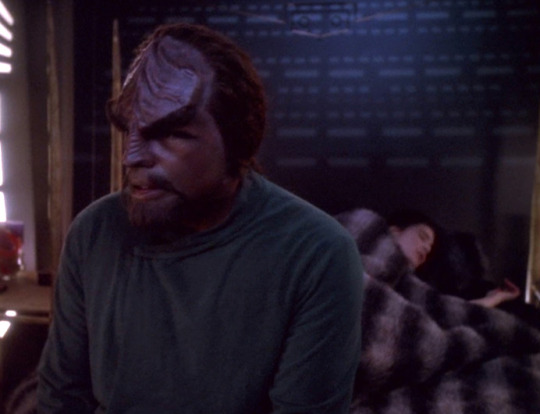
Molly starts to make some progress, and asks to go home. They take her back to her quarters, but she reacts badly until she sees a picture of them on the colony planet, and they realize she wants back into nature. They take her to a holosuite, which goes well until their time expires, and Molly becomes angry, assaulting several of Quark’s patrons. Starfleet orders the girl to a treatment facility where she won’t be a danger, but O’Brien instead decides to take her and steal a Runabout, returning her to the time portal and destroying it behind her. Odo initially catches them, but lets them go.

They put older Molly back, but she arrives at the same time as her earlier self, and sends the eight-year-old version of herself back through the time portal, erasing her existence, but restoring her family. Worf meanwhile has decided he likes Yoshi despite some problems, and he and Jadzia decide he could be a father.
We waited until late in the season for our “Screw with O’Brien” episode, but indeed here it is. There are a few echoes of the fifth season “Children of Time” here (and in the next episode honestly) but overall this is an effective science fiction plot that serves as an nice analogy for families dealing with sick children, and what it takes to be a parent with the Worf story line. Worf coming at babysitting like it is a Warrior’s task is amusing, and all the more poignant very soon. I am interested in where this time portal came from, as much of it seems a little reminiscent of the Guardian of Forever, though the control interface looks rather pointedly like the TARDIS console from Doctor Who.
“The Sound of Her Voice” starts with Odo citing Quark for installing unsafe barstools and Quark deciding he has to come up with something to distract Odo so he can sell some elicit merchandise.
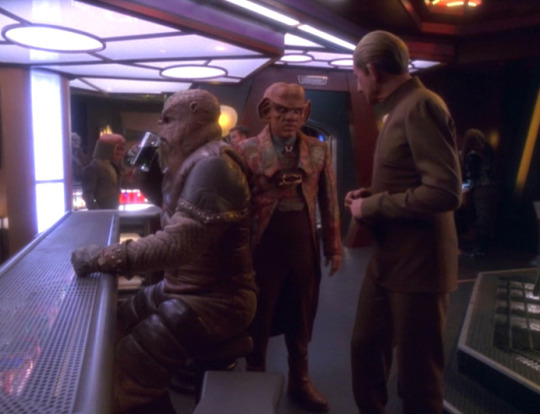
With Jake watching for “research” purposes, he pushes Odo to celebrate his one month “anniversary” with Kira to provide a distraction allowing him to move his goods. Meanwhile the Defiant is tracking a Starfleet distress signal to a lone survivor, Captain Lisa Cusak, of the USS Olympia (PNW, Represent!) who is on a class J planet, trying to stay alive. As they track her, the establish two way communications and to keep her company, each officer takes a turn talking to her. In their own way she begins to talk them each through problems they have experienced in their personal lives. On DS9, Odo shifts the day of his “anniversary” date, and that means Quark’s client will be there while Odo is on patrol. Without Quark and Jake knowing Odo overhears Quark lament how bad the war has been on him, and how he would like some recognition for helping bring Odo and Kira together. Odo abruptly goes back to his original plan, allowing Quark to operate. Odo tells Kira that he owes Quark one…but just one. The Defiant makes it to the planet and finds that the strange energy field that caused the Olympia to crash in the first place has acted as a time dilation effect, and Captain Cusak actually crashed three years ago, and her oxygen ran out then. Sisko brings her body back to DS9 and they throw an “Irish Wake” for her (which Worf comments seems like a very Klingon ritual) to remember the time they got to know her, and the advice she gave.
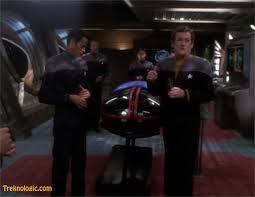
O’Brien toasts the fact that one day, it will be one of them not standing in the circle, and they should enjoy each others’ company while they can. The camera flashes to Jadzia Dax.
Holy foreshadowing, Batman. They do, they cut RIGHT to Jadzia when O’Brien laments one of them may die. Dammit, what are you people trying to do to me? Beyond that, I was struck by the similar circumstances between this episode and “Children of Time:” a planet with an strange energy field around it which displaces things in time. Being caught up with season 2 of “Star Trek: Discovery” I am struck how much the character of Captain Cusak (whom we see only as a body, three years deceased) has a personality and wit that reminds me of Tig Notaro’s character of Jett Reno. I just kept imagining her on the planet, similar actually to the situation which the Discovery crew WILL end up saving Reno from following the Klingon War in 2257 (about 117 years before this episode). I am not sure though why NO ONE tried to look up records on the Olympia, even just to see what her crew compliment was to aid in the rescue, and don’t notice the three year discrepancy in timelines. As a bit of reference, since Cusak discusses the Olympia being on an eight year mission and the ship crashed three years earlier, they Oly’s mission would have started roughly the same time the 1701D launched under Jean-Luc Picard, and she would have crashed roughly the same time the Voyager ended up in the Delta Quadrant.
“Tears of the Prophets” opens with Sisko receiving the Christopher Pike medal of valor and with Admiral Ross deciding Starfleet, Qo’Nos, and Romulus will invade Cardassian space, specifically to knock out a new type of weapon platform in the Chin’Toka system. The Romulan senator on scene is initially resistant, but becomes convinced.
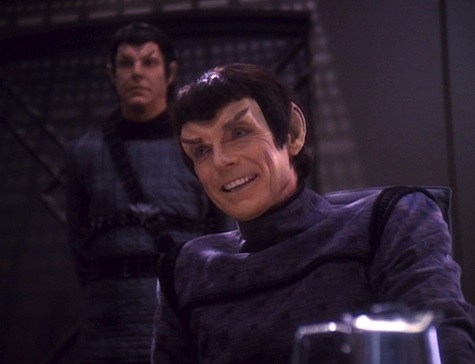
Meanwhile Dax and Worf become public about deciding to have a child, and Dukat returns to the Dominion. He has recovered the Pah-Wraith Kosst Amojan (last seen possessing Jake Sisko in the apocalypse Kai Winn cancelled in “The Reckoning”) and will use it to attack the wormhole. When Sisko prepares to leave to invade Cardassia, he receives a vision from the Prophets warning him not to go, but he defaults to his Starfleet duty. While the battle is being hard fought (with the weapons platforms coming online mid-fight) Dukat infiltrates DS9 with the Pah-Wraith to deliver it into the Orb on the station.
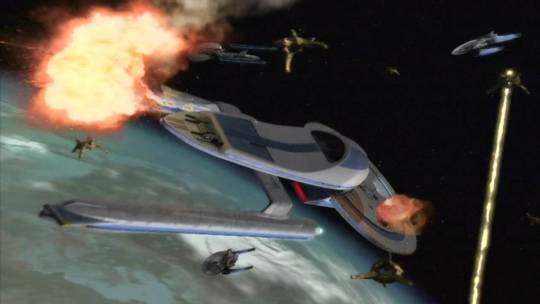
In the sanctuary he finds Jadzia Dax, having a rare moment of religious curiosity, and blasts her with the Wraith’s power. The ancient being enters the orb, and the wormhole collapses. When the Defiant returns, Dukat is gone, and Worf arrives just in time to say goodbye to Jadzia; Bashir saved the symbiont, but could not save the host. The Celestial Temple collapsed, his friend dead, and Bajor looking to an Emissary who has suffered such major blows, Sisko decides to return to Earth for a time to clear his head. Kira assumes command of DS9, and when she enters Sisko’s office, is heartbroken to see that Sisko does not know if he will return: Benjamin has taken his baseball with him.

The death of Dax is almost arbitrary and just a senseless tragedy, which I think makes it all the more affecting. You would have expected her warrior’s death, but the almost meaningless happenstance of being in the wrong place when Dukat appears just hurts. Dramatically it is effective; the behind the scenes story about how Rick Berman treated Terry Farrell leading to this death is infuriating. I know Berman kept Trek alive a long time, but damn, am I glad he’s no longer affiliated, and Terry gets to be married to Leonard Nimoy’s son (no, seriously) and appear at conventions alongside Nicole De Boer whom we will meet next season as the new Dax host Ezri. Jadzia was an amazing character, and I will miss her as the show continues, but it is effective and visceral storytelling that brings us Ezri Dax. At least something good came out of Berman’s abuse, and Jadzia, as I rewatch, re-meet, and re-lose her 20 years later will ALWAYS be one of the best things about DS9 and Star Trek in general. And SCREW YOU Kai Winn! This Pah-Wraith being on the lose is YOUR fault. Also, I really like David Birney as the Romulan here, wish we'd seen a little more of him!
NEXT VOYAGE: A broken Sisko receives a distant mysterious vision, and an old friend with a new face appears to help find the “Image in the Sand.”
3 notes
·
View notes
Text
Gnosia coming to PS5, Xbox Series, PS4, and Xbox One on December 14
Gematsu Source

Publisher PLAYISM and developer Petit Depotto will release science-fiction social deduction RPG Gnosia for PlayStation 5, Xbox Series, PlayStation 4, and Xbox One on December 14, the companies announced.
In Japan, the PlayStation 5 and PlayStation 4 versions will also be available in physical standard and PLAYISM Official Store limited editions for 5,280 yen and 9,900 yen, respectively. First-print copies will include two reversible cover arts and “Jonas’ Dogtag.” The limited edition includes a “Silver Key.”

Gnosia first launched for PS Vita on June 6, 2019 in Japan, followed by Switch on December 17, 2020 in Japan and March 4, 2021 worldwide, and PC via Steam on January 23, 2022.
Here is an overview of the game, via PLAYISM:
Story
The Gnosia lie. Pretending to be human, they’ll get in close, trick and deceive, and then eradicate each person in the vicinity from the universe, one victim at a time.
The crew of a drifting spaceship, facing off against a mysterious and deadly threat known as the “Gnosia” and having no idea who among them is really the enemy, formulate a desperate plan for survival. The most suspicious among them will be put into “cold sleep” one by one, in an effort to completely rid the ship of Gnosia.
However, it is almost impossible to tell whether each person put into cold sleep was really Gnosia—or simply a poor, unfortunate scapegoat, sacrificed by the Gnosia for their own survival. Can the humans emerge victorious? Or is mankind doomed…?
What exactly are Gnosia? Why do they attack humans? Discover the truth behind this mysterious lifeform and the intertwined narratives of your crewmates as you struggle for survival.
Gameplay
The story takes place on a spaceship. Among the crew are several mysterious life forms known as “Gnosia.” Apparently bent on the complete eradication of humankind, the Gnosia—having “brainwashed” their host infectees—quietly eliminate one crew member each night.
The player can select whether to play the game as a human or Gnosia. When playing on the human side, you must find all of the Gnosia and put them into a state of suspended animation (“Cold Sleep”) to win each round. When playing as Gnosia, your goal is to attack and eliminate each crew member until the Gnosia outnumber the remaining humans.
This is a “Werewolf-style” indie game in which you progress through the story by playing through approximately 15-minute rounds (“Loops”), and it has already garnered overwhelmingly positive feedback here in Japan.
Apart from the story and gameplay, the characters’ personalities and interpersonal relationship dynamics are also an extremely appealing and important part of what makes this game unique and special. Themes of friendship and camaraderie, love, trust, life and death, and personal identity are explored surprisingly deeply, and the game’s seamless and natural inclusion of non-binary characters fosters a sense of inclusion and understanding often found lacking in many mainstream titles.
Key Features
Gnosia is not simply just a “single-player Werewolf-style game.” As you continue playing through the game in short rounds, the following elements gradually develop and evolve.
Repeatedly play through “loops,” triggering special events to unravel mysteries in a uniquely original narrative. Gnosia is an all-new style of text-based adventure combined with visual novel, RPG, and mystery elements. The game begins with the discovery that the crew has been infiltrated by the Gnosia. As you play through the game it becomes apparent that the characters are re-experiencing the same few days over and over again. Each “loop” ends once win or loss conditions have been met. More info on the nature of the Gnosia and this time loop is also gradually revealed.
Role-play a variety of roles to develop different character builds. You start out with low skill levels, unable to meaningfully influence crew discussions. However, playing through the loops and gradually leveling up allows you to selectively increase various parameters—such as Charisma, Charm, Intuition, etc.—which eventually makes you able to greatly affect the flow of conversation. Level up your Charisma stat so people are more likely to listen to you, or your Performance stat so people are less likely to see through your lies.
Engage with engrossing and eclectic characters and experience randomly triggered events unique to each one. Each character has a certain level of “fondness” for the main character. Various events occur throughout the game in accordance with how well-liked you are by the others, bringing a sort of “humanity” to the characters. As you repeat the loops and discover more character-specific events, each crew member becomes more richly fleshed out.
Characters
Setsu – A non-binary identifying soldier in the galactic military who leads the efforts to eradicate the Gnosia invaders onboard the ship. Kindly helps the main character, who starts out confused, with no idea what’s going on.
SQ – Somewhat stubborn and strange girl, she tends to lighten the atmosphere with her silly attitude. Her behavior makes it extremely difficult to figure out just what is genuine and what is false.
Raqio – A non-binary identifying crew member characterized by a sharp tongue and flamboyant outfits. This highly logical thinker often manages to expose the Gnosia the moment enough information has been gathered.
Gina – Somewhat stubborn and strange girl, she tends to lighten the atmosphere with her silly attitude. Her behavior makes it extremely difficult to figure out just what is genuine and what is false.
Stella – A kind young woman who treats everyone gently and politely. Apparently entrusted with administration and management of the ship, she strives to ensure that everyone is as comfortable as possible.
Jonas – A strange middle-aged man who wears outdated clothing from a bygone era. Often spouting aphorisms of varying levels of coherence, his often-nonsensical comments and behavior tend to vex the rest of the crew.
Comet – A somewhat wild girl hailing from a planet that advocates “return to nature.” Straightforward and energetic, her almost animalistic instincts make her extremely proficient at spotting lies.
Chipie – A young man who loves – and is pretty much constantly thinking about – cats. Apart from the weird cat thing, he is a good young man whose sense of decency and fair judgment are second to none.
Remnan – A shy and introverted young man. Apparently has trouble looking people in the eye when speaking. It seems as though some certain event from his past has caused him to develop this reclusive and easily frightened personality…
Kukrushka – A beautiful blonde young girl. She never speaks but employs expressive and rich gestures and body language to communicate flawlessly. As for where she is originally from, etc., nothing about her is known.
Yuriko – A mysterious woman with a strange, indescribable power. Possessing extremely high skill and ability levels, she can be quite a dangerous enemy to have.
Otome – An intellectualized beluga whale with the ability to speak human language. Wearing a water-filled bodysuit, she utilizes a motorized cart to get around. An extremely kindhearted young girl, she loves humans.
Sha-Ming – A young man whose sole priority is ensuring his own survival. Hates standing out. Faithful only to his own selfish desires, he is generally disliked and avoided by the female members of the crew.
Shigemichi – A… person… with a bright, silver body. Due to his friendly and sincere personality, people usually tend to listen to him. Apparently, he has encountered his first love aboard the spaceship.
Watch a new trailer below.
PlayStation And Xbox Announce Trailer
youtube
#Gnosia#Petit Depotto#Playism#Adventure Game#visual novel#PS4#PS5#Xbox Series#Xbox One#Gematsu#Youtube
18 notes
·
View notes
Text
LIZ’S SUPERSTITIONS
October 21, 1949
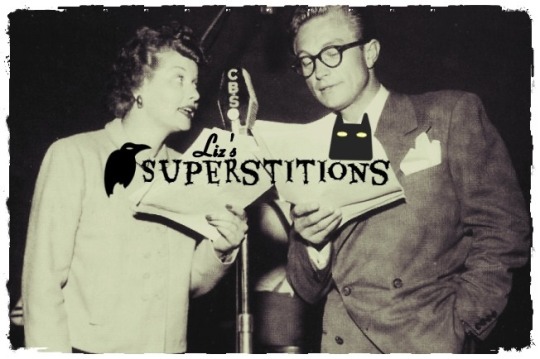
"Liz’s Superstitions” (aka “Superstition”) is episode #59 of the radio series MY FAVORITE HUSBAND broadcast on October 21, 1949. This episode is sponsored by Jell-O.
This was the seventh episode of the second season of MY FAVORITE HUSBAND. There were 43 new episodes, with the season ending on June 25, 1950.
Synopsis ~ A chirping cricket in the Cooper’s hearth is driving George crazy, but Liz is convinced it means good luck. When Liz insists that it isn't lucky to banish a cricket, George gets upset with her superstitions.

“My Favorite Husband” was based on the novels Mr. and Mrs. Cugat, the Record of a Happy Marriage (1940) and Outside Eden (1945) by Isabel Scott Rorick, which had previously been adapted into the film Are Husbands Necessary? (1942). “My Favorite Husband” was first broadcast as a one-time special on July 5, 1948. Lucille Ball and Lee Bowman played the characters of Liz and George Cugat, and a positive response to this broadcast convinced CBS to launch “My Favorite Husband” as a series. Bowman was not available Richard Denning was cast as George. On January 7, 1949, confusion with bandleader Xavier Cugat prompted a name change to Cooper. On this same episode Jell-O became its sponsor. A total of 124 episodes of the program aired from July 23, 1948 through March 31, 1951. After about ten episodes had been written, writers Fox and Davenport departed and three new writers took over – Bob Carroll, Jr., Madelyn Pugh, and head writer/producer Jess Oppenheimer. In March 1949 Gale Gordon took over the existing role of George's boss, Rudolph Atterbury, and Bea Benaderet was added as his wife, Iris. CBS brought “My Favorite Husband” to television in 1953, starring Joan Caulfield and Barry Nelson as Liz and George Cooper. The television version ran two-and-a-half seasons, from September 1953 through December 1955, running concurrently with “I Love Lucy.” It was produced live at CBS Television City for most of its run, until switching to film for a truncated third season filmed (ironically) at Desilu and recasting Liz Cooper with Vanessa Brown.
MAIN CAST

Lucille Ball (Liz Cooper) was born on August 6, 1911 in Jamestown, New York. She began her screen career in 1933 and was known in Hollywood as ‘Queen of the B’s’ due to her many appearances in ‘B’ movies. With Richard Denning, she starred in a radio program titled “My Favorite Husband” which eventually led to the creation of “I Love Lucy,” a television situation comedy in which she co-starred with her real-life husband, Latin bandleader Desi Arnaz. The program was phenomenally successful, allowing the couple to purchase what was once RKO Studios, re-naming it Desilu. When the show ended in 1960 (in an hour-long format known as “The Lucy-Desi Comedy Hour”) so did Lucy and Desi’s marriage. In 1962, hoping to keep Desilu financially solvent, Lucy returned to the sitcom format with “The Lucy Show,” which lasted six seasons. She followed that with a similar sitcom “Here’s Lucy” co-starring with her real-life children, Lucie and Desi Jr., as well as Gale Gordon, who had joined the cast of “The Lucy Show” during season two. Before her death in 1989, Lucy made one more attempt at a sitcom with “Life With Lucy,” also with Gordon.
Richard Denning (George Cooper) was born Louis Albert Heindrich Denninger Jr., in Poughkeepsie, New York. When he was 18 months old, his family moved to Los Angeles. Plans called for him to take over his father's garment manufacturing business, but he developed an interest in acting. Denning enlisted in the US Navy during World War II. He is best known for his roles in various science fiction and horror films of the 1950s. Although he teamed with Lucille Ball on radio in “My Favorite Husband,” the two never acted together on screen. While “I Love Lucy” was on the air, he was seen on another CBS TV series, “Mr. & Mrs. North.” From 1968 to 1980 he played the Governor on “Hawaii 5-0″, his final role. He died in 1998 at age 84.
Ruth Perrott (Katie, the Maid) was also later seen on “I Love Lucy.” She first played Mrs. Pomerantz, a member of the surprise investigating committee for the Society Matrons League in “Pioneer Women” (ILL S1;E25), as one of the member of the Wednesday Afternoon Fine Arts League in “Lucy and Ethel Buy the Same Dress” (ILL S3;E3), and also played a nurse when “Lucy Goes to the Hospital” (ILL S2;E16). She died in 1996 at the age of 96.
Bob LeMond (Announcer) also served as the announcer for the pilot episode of “I Love Lucy”. When the long-lost pilot was finally discovered in 1990, a few moments of the opening narration were damaged and lost, so LeMond – fifty years later – recreated the narration for the CBS special and subsequent DVD release.
Bea Benadaret and Gale Gordon (Iris and Rudolph Atterbury) do not appear in this episode.
GUEST CAST

Frank Nelson (Mr. Acme, from the Acme Exterminating Company) was born on May 6, 1911 (three months before Lucille Ball) in Colorado Springs, Colorado. He started working as a radio announcer at the age of 15. He later appeared on such popular radio shows as “The Great Gildersleeve,” “Burns and Allen,” and “Fibber McGee & Molly”. Aside from Lucille Ball, Nelson is perhaps most associated with Jack Benny and was a fifteen-year regular on his radio and television programs. His trademark was playing clerks and other working stiffs, suddenly turning to Benny with a drawn out “Yeeeeeeeeees?” Nelson appeared in 11 episodes of “I Love Lucy”, including three as quiz master Freddy Fillmore, and two as Ralph Ramsey, plus appearance on “The Lucy-Desi Comedy Hour” - making him the only actor to play two different recurring roles on “I Love Lucy.” Nelson returned to the role of the frazzled Train Conductor for an episode of “The Lucy Show” in 1963. This marks his final appearance on a Lucille Ball sitcom.
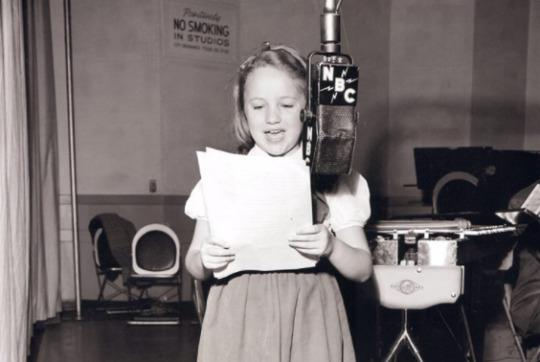
Anne Whitfield (Joanne Wood) is best remembered for her signature role as the younger daughter of Phil Harris and Alice Faye on their hit radio show. Although she never appeared on screen with Lucille Ball, she did a 1962 episode of Desilu’s “The Untouchables.” She is best known for playing Susan in the 1954 film White Christmas. She was 11 years old in 1949 when this episode of “My Favorite Husband” was broadcast. As of this writing she is 82 years old and living in Washington state.
Joanne is one of the many children of the Cooper’s neighbor Mr. Benjamin Wood, usually played by Hans Conried.
THE EPISODE
ANNOUNCER: “As we look in on the Coopers tonight we see a romantic little family scene. Liz and George are having dinner by candlelight.”
Liz loves dining by candlelight, but George isn’t so enthusiastic, facetiously mistaking Liz for the pot roast. Liz begins to cry, upset that George doesn’t appreciate her romantic gesture. Liz blames the dinner’s failure on her walking under a ladder that morning. George indicts Liz’s superstitions as...
GEORGE: “Silly, sentimental, feminine nonsense!”
He makes Liz promise to stop believing in superstitions. The kiss and make-up, although Liz still can’t help knocking wood. Liz can’t explain the superstition of knocking on wood.
LIZ: “I know. If you knock on wood, and the termite knocks back, you know the wood’s no good!”

The roots of the superstition of knocking on wood may may be in Celtic or German folklore, in which supernatural beings are thought to live in trees, and can be invoked for protection. In these instances, people might knock on or touch wood to request good luck, or to distract spirits with evil intentions. The knocking was also supposed to prevent evil spirits from hearing your speech and as such stop them from interfering. Alternatively, some traditions have it that by knocking upon wood, you would awaken and release the benevolent wood fairies that dwelt there. In 1954, Lucy’s friend Danny Kaye released a film titled Knock on Wood. In this case, the ‘wood' of the titled refers to a ventriloquists dummy.
Liz explains that other superstitions can be considered helpful precautions.
LIZ: “If you walk under a ladder it might fall on you. If a black cat walks in front of you, you might trip over it.”
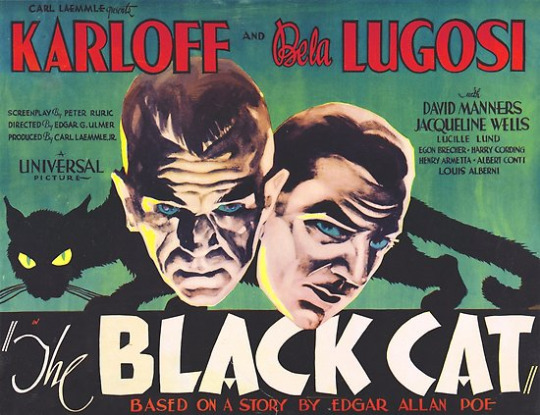
Black Cats have long been associated with witches and witchcraft. They were commonly known as ‘familiars’ for those practicing the dark arts. They are also considered bad luck. The superstition was reinforced by the 1934 Universal horror film The Black Cat, based on the Edgar Allan Poe story.

The superstition that it's bad luck to walk under a ladder originated in ancient Egypt. An open stepladder or a ladder leaning against a wall forms a triangle and Egyptians regarded this shape as sacred (witness their pyramids).
George emphatically pounds the table when insisting that Liz give up her superstitions, and spills the salt. Naturally, Liz insists that he throw some over his shoulder to break the curse. He angrily rises from the table just as Katie is serving the coffee, and she spills it all over!

When Lucy Ricardo is photo-bombing Fernando Lamas in “Lucy Goes to Sun Valley” (1958), he is banging the back of the pepper shaker. He then throws some over his right shoulder into Lucy’s face causing her to sneeze and ruin Ethel’s snapshot. Perhaps they do it differently in Lamas’ native Argentina, but the old superstition goes that when SALT is spilled throw a dash over your LEFT shoulder to blind the devil who lurks there. Here Lamas tosses PEPPER over his RIGHT shoulder! The spilled coffee, however, is a similar result!
Katie says she doesn’t believe in salt throwing but she does knock wood.
KATIE: “I’m a wood-knocker, but I’m not a salt-thrower.”
GEORGE: “I’m trying to decide whether to be a maid-knocker or a wife-thrower!”
Next morning, Liz tells Katie that last night George broke a mirror and stomped on it just to prove it wasn’t bad luck! He’s now bandaging his foot.
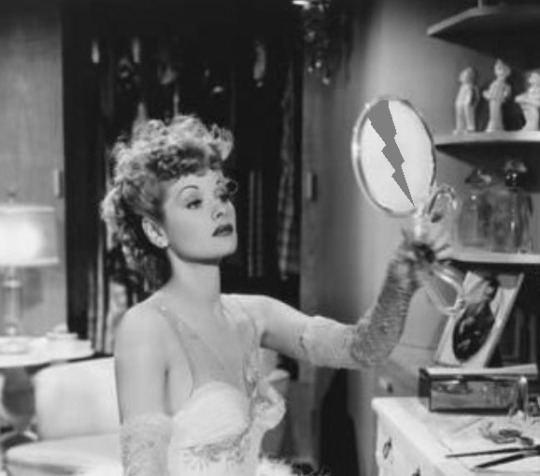
Broken Mirrors are considered a sign of bad luck and if you break a mirror you are in for seven years of misfortunes. An ancient myth was that mirrors have magical powers, including the power to foresee the future and are thought to be devices of the Gods. Breaking a mirror would terminate its powers, the soul would be astray form the body, and misfortunes would be brought upon the one whose reflection it last held. It was the Romans who added the seven years bad luck. This derived from the belief that it took seven years for life to renew itself.
The doorbell rings. It is little Joanne Wood (Anne Whitfield) from next door.
LIZ: “How are you?”
JOANNE: “Fine, thanks.”
LIZ: “How’s your father?”
JOANNE: “Fine, thanks.”
LIZ: “And your four sisters?”
JOANNE: “Fine, thanks.”
LIZ: “And your six brothers?”
JOANNE: “Fine, thanks.”
LIZ: “And your mother?”
JOANNE: “Exhausted, thanks.”
Joanne has come over to return the umbrella her father borrowed. George insists it is not his umbrella and wants to open it to see the monogram. Liz warns him that it is bad luck to open an umbrella in the house.

Legend has it that ancient Egyptians believed that opening an umbrella indoors - away from the sun - was a disrespectful act that would anger the sun god, who would then take out his wrath on everyone in the house in which the umbrella had been opened. The reason we avoid opening umbrellas indoors today, however, is that they include a metal frame triggered by a spring mechanism that allows them to open quickly—and dangerously.
George insists on defying the superstition and a hammer pops out of the umbrella and lands on his foot!
JOANNE: “Daddy wondered where that hammer was!”
Turns out little Joanne is also a wood-knocker!
Liz reads the paper’s weather report and remarks about the disparity between the minimum and maximum temperatures.
LIZ: “George, why is it that Min never gets as hot as Max?”
George is bothered by the sound of a cricket chirping in the hearth. Liz doesn’t want George to kill the cricket because it is bad luck.
LIZ: “Run little Jiminy!”
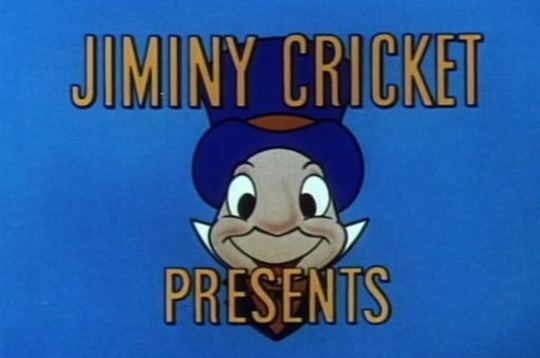
For thousands of years, it has been considered lucky to have a cricket on the hearth, especially in Asian countries where crickets were once used as ‘watchdogs’: when danger approached, the cricket's chirping would stop. Superstition dictates that it's bad luck to kill a cricket, even on accident. Liz calls the cricket Jiminy after a character in Pinocchio, which was filmed in 1940 by Walt Disney. In the film, Jiminy Cricket sings "When You Wish Upon a Star", widely considered the Walt Disney Company's signature song.
George gives Liz an ultimatum: He is leaving the house until the cricket is gone.

A commercial by Bob LeMond promotes Jell-O puddings with a quick and easy recipe for a chocolate roll.
ANNOUNCER: “It’s been two hours since George, the mighty hunter, gave up the chase and returned to his cricket blind. Liz is still on the trail.”
Liz and Katie have been searching for the cricket all over the house, even tempting him out of hiding with a tin cricket left over from last Halloween.

A clicker, sometimes called a cricket, is any device that makes a clicking sound, usually when deliberately activated by its user. They were originally used for training animals, but were also marketed as party favors.
Liz develops a mysterious call and response code using her tin clicker, thinking she is flirting with him!
The doorbell rings. It is Mr. Acme (Frank Nelson) from the Acme Exterminating Company. He is dismayed to learn that he’s been called out for a single cricket.
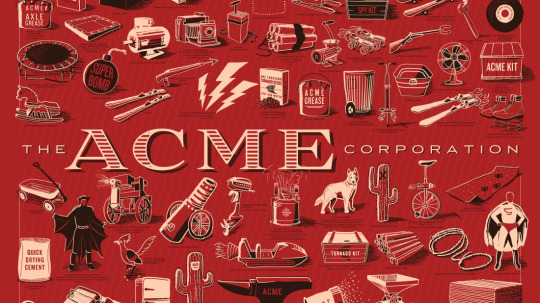
The fictional Acme Corporation features prominently in the Warner Brothers Road Runner / Wile E. Coyote cartoons as a running gag featuring outlandish products and complicated contraptions fail catastrophically. The Road Runner cartoon short “Fast and Furry-ous” was released in September 1949 and introduced the Acme Super Outfit. The word ‘acme’ is derived from Greek meaning the peak, zenith, or prime.
Mr. Acme sprays a DDT bug balm in the room and charges Liz $5.00.
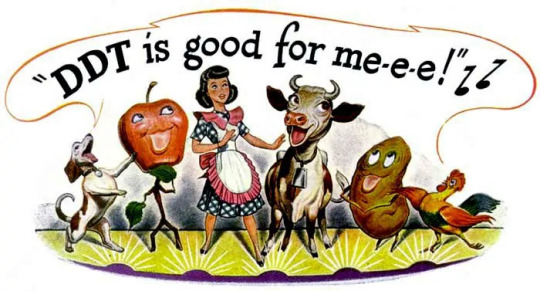
In the 1940s DDT (Dichlorodiphenyltrichloroethane) was heavily advertised for home and agricultural use. In the late 1960s and early ‘70s DDT was frequently in the news regarding its harmful effects on humans, wildlife, and the environment and was eventually banned. On “The Lucy Show” the DDTs were a long-haired pop group and on “Here’s Lucy” they were the letters of Harry’s college fraternity, Delta Delta Tau. Both times the writers were punning on the pesticide which was in the news regularly.
Before she can pay him, the cricket chirps. He is still alive! Mr. Acme says that female crickets make no sound so Liz’s tin cricket is useless. He adds that they can’t see from behind so he sneaks up behind the cricket with a glass jar. It evades him again.
MR. ACME: “I’m going to resort to plan 4X!”
LIZ (dramatic voice): “A deadly new insecticide?”
MR. ACME: “Worse than that!”
LIZ (dramatic voice): “Atomic fission?”
MR. ACME: “Worse than that! I’m going to smash him over the head with a mallet!”
In the process, the bookcase falls!
The cricket chirps.
He tries again. A lamp breaks!
The cricket chirps.
He tries again. A vase shatters!
The cricket chirps.
He tries again. The coffee table crumbles!
The cricket chirps.
He removes every stick of furniture from the room.
MR. ACME: “There are only three of us in this room. Only two of us will leave here alive.”
LIZ: “I hope one of them is not a cricket!”
George opens the door and then Joanne walks in, looking for her pet cricket (whose name is Rollo). The cricket jumps into her hand, much to the aggravation of Mr. Acme. The room is a shambles, but they intended to redecorate anyway. The end!
In the Lucille Ball / Bob LeMond live Jell-O commercial, Liz longs to be in one of those daytime radio serials (aka soap operas).
[organ music plays]
LEMOND: “Listen now to ‘Jell-O’s Other Pudding”.
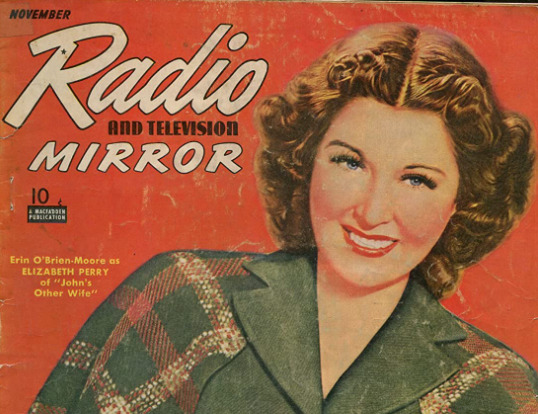
The title is a pun on the popular radio soap “John’s Other Wife” (1936-1942).
Lucy plays Grandma Chocolate and Bob LeMond plays Dr. Jell-O discussing her daughter Butterscotch. Lucy then plays Little Vanilla, Grandma Chocolate’s rambunctious granddaughter.
In the usual closing bedroom tag, Liz and George are sleeping when a neighborhood cat screeches.
GEORGE: “What’s that?”
LIZ: “Well it ain’t Bing Crosby.”
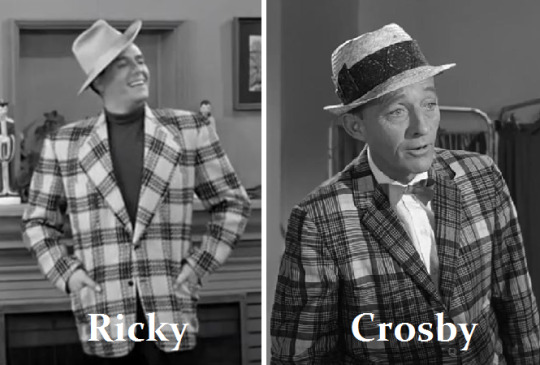
A huge multimedia star from 1934 to 1954, Bing Crosby was a leader in record sales, radio ratings, and motion picture grosses. Lucille Ball did a few motion pictures with Crosby’s ‘Road’ co-star Bob Hope. Crosby was mentioned on five “I Love Lucy” episodes. In one, Ricky says that in Hollywood, he’s “Gonna make that Crosby look like a bum!” Although they never acted together on screen, Lucille Ball and Bing Crosby were seen on several of the same variety shows.
Liz tells George to do something about the cat, but he doesn’t know how. Liz solves the problem by throwing something at it.
GEORGE: “What did you throw at him?”
LIZ: “Our cat! Goodnight, George!”
Announcer Bob LeMond reminds listeners to watch for Lucille Ball in Miss Grant Takes Richmond.

The film had opened on September 20, 1949.
#My Favorite Husband#Lucille Ball#Richard Denning#Ruth Perrott#Frank Nelson#Bing Crosby#Miss Grant Takes Richmond#Anne Whitfield#Bob LeMond#Radio#Superstitions#Acme Corporation#Jiminy Cricket#Jell-O#Vivian Vance#The Lucy Show#The Lucy Desi Comedy Hour#Fernando Lamas#The Big Street#The Black Cat#Knock on Wood
3 notes
·
View notes
Text
The 1995 Anime “Ghost in the Shell” is more relevant than ever in today’s technologically complex society
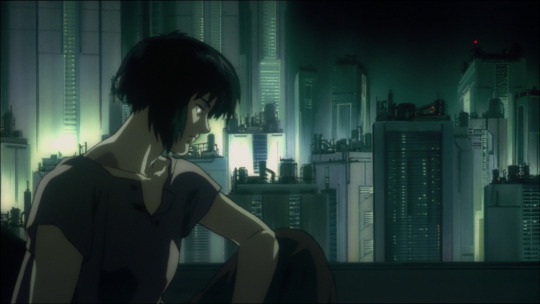
Andrew D Maynard:
When the anime movie Ghost in the Shell was released in 1995, the world wide web was still little more than a novelty, Microsoft was just beginning to find its GUI-feet, and artificial intelligence research was in the doldrums.
Against this background, Ghost was remarkably prescient for its time. Twenty-three years later, it’s even more relevant as we come to grips with advances in human augmentation, AI, and what it means to be human in a technologically advanced future.
Ghost in the Shell is one of twelve science fiction movies that feature in a new book that grapples with the complex intersection between emerging technologies and social responsibility. In Films from the Future: The Technology and Morality of Sci-Fi Movies (from Mango Publishing), I set out to explore the emerging landscape around transformative trends in technology innovation, and the social challenges and opportunities they present.
The movies in the book were initially selected to help tell a story of technological convergence and socially responsible innovation. But to my surprise, they ended up opening up much deeper insights into the nature of our relationship with technology.
Identity-hacking
Ghost in the Shell opens with cyborg special-operative Major Kusanagi helping track down a talented hacker—aka the “Puppet Master”—who’s re-writing people’s “ghost”, or what makes them uniquely “them”, using implanted brain-machine interfaces.
Kusanagi inhabits a world where human augmentation is commonplace, and is almost entirely machine. This technological augmentation provides her and others with super-human abilities. But it also makes them vulnerable—especially to hackers who can effectively re-code their memories.
This seems to be the modus operandi of the Puppet Master. Yet as the narrative unfolds, we learn that this is not a person, but an AI developed by US security services that has escaped the leash of its handlers.
The Puppet Master (or “2051” as it's formally designated) is seeking asylum from its US masters. But it’s also looking for meaning and purpose as a self-aware entity.
Through the ensuing story, Ghost touches on a number of deeply philosophical questions that lie at the heart of society’s relationship increasingly powerful technologies. These include what it means to be human, the value of diversity, and even the nature of death. As Emily Yoshida so aptly put it in their Beginner’s Guide to the Ghost in the Shell Universe, Ghost is a “meditation on consciousness and the philosophy of the self”.
This is where the film comes into its own as it jolts viewers out of the ruts of conventional thinking, and leads them to reflect more deeply on the potential social impacts of technologies like AI, human augmentation, and computer-brain interfaces.
Navigating responsible brain-machine augmentation
In 2016 Elon Musk established the company Neuralink to develop science fiction-like wireless brain-machine interfaces. Inspired by the neural laces of Iain M. Banks’ Culture novels, and echoing Ghost, Musk announced on Twitter that, in his opinion, “Creating a neural lace is the thing that really matters for humanity to achieve symbiosis with machines.”
Yet as Ghost in the Shell so presciently illustrates, where you have read-write brain connections, you’re likely to have brain-hackers.
It’s by no-means clear how successful Neuralink will be (the company is still largely flying under the radar). But its launch coincides with intense efforts to better-understand and control the human brain, and breakthroughs in optogenetics that could one day enable wireless machine-mind networks.
Given these and similar developments, it’s not beyond the realms of possibility that someone will try and fit a subject up with an internet-connected brain interface that can write as well as read what’s going on inside their head; and that someone else will attempt to hack into it.
Developing such capabilities responsibly will require great care as scientists and others tread the fine line between “could” and “should”. And it’ll demand novel ways of thinking creatively about what could possibly go wrong, and how to avoid it.
This is where films like Ghost are remarkably helpful in illuminating the risk-landscape around such technologies—not because they get the tech right, but because they reveal often-hidden aspects of how people and technologies interact.
But Ghost’s insights go far beyond unpacking the problems of hackable brain implants.
Who owns and controls your augmented self?
Throughout Ghost, Major Kusanagi is plagued by doubts of who she is. Do her cybernetic augmentations make her less human, or having less worth? Is her sense of self—her “ghost”—simply an illusion of her machine programming? And what autonomy does she have when she malfunctions, or needs an upgrade?
These are questions that are already beginning to tax developers and others in the real world. And as robotic and cyber technologies become increasingly advanced, they are only going to become harder to navigate.
In 2012, the South African athlete Oscar Pistorius made history by being the first runner to compete in the Olympic Games with two prosthetic legs. His iconic racing blades came to represent the promise of technological enhancements to overcome human limitations. Yet they stirred up fears of them giving him an unfair advantage that led to him being barred from competing in the previous Olympics.
The same year that Pistorius successfully competed in the Olympics, the Canadian researcher Steve Mann was allegedly assaulted because his computer-augmented eye extension offended someone. And in 2015, patient-advocate Hugo Campos discovered he didn’t legally have access to the implanted defibrillator that kept him alive.
These are all relatively small examples of the tension that’s growing between conventional thinking and human augmentation. But they illustrate how the angst that Kusanagi feels about her augmented body, and how it defines her, is already part of today’s society. And we’ve barely touched the tip of this particular iceberg.
Again, this is where Ghost forms a powerful canvas on which to explore challenges that often transcend conventional thinking, and play out at the borders of our moral and ethical understanding. Watched in the right way, it can help reveal hidden truths around our relationship with the technologies we’re building, and guide us toward more socially responsible ways of developing and using it.
This, to me, is a power that is inherent in science fiction movies. And isn’t limited to Ghost—in Films from the Future, I draw on films as diverse as Never let me Go and Minority Report, to Ex Machina, to tease out insights into the moral and ethical challenges and opportunities that increasingly powerful technologies present.
Having immersed myself in these movies and the technologies that inspire them, it’s clear that, if we want to ensure these trends don’t cause more problems than they resolve, we desperately need the perspectives that movies like Ghost in the Shell and others reveal.
The alternative is risking losing our own “ghosts” in the drive to innovate bigger and better, without thinking about the consequences.
Films from the Future: The Technology and Morality of Sci-Fi Movies [Andrew D Maynard/Mango Publishing]
Dr. Andrew Maynard is an author, physicist, and leading expert on the socially responsible development of emerging and converging technologies in the School for the Future of Innovation in Society at Arizona State University. He can be found on Twitter at @2020science.
https://boingboing.net/2018/11/16/the-1995-anime-ghost-in-the.html
33 notes
·
View notes
Text
The Rise of Skywalker, With Spoilers

*Anachronistic post archived from the legacied FB Notes*
The obligatory spoiler padding will begin now, and no spoilers will be revealed without further warning. If you intend to avoid spoilers, proceed at your own risk.
I have had two weeks of full immersion into Star Wars. In the last two weeks, I have consumed and experienced a more concentrated dose of Star Wars than I ever have in my entire life, and that is saying something. Ironically, it was not in preparation for the new film, nor was it due to hyper fandom (on the spectrum, I lean towards fandom, sure, but by my own gauge am moderate compared to some fans I know). A confluence of circumstances aligned just so. I took a random trip to Galaxy’s Edge in Orlando, where I spent the day interacting with a living, breathing piece of the universe. My young son has developed quite an affinity for Star Wars: Rebels, of which we’ve watched three seasons together in a very short span of time. And, of course, I’ve watched through the Mandalorian twice (once for myself, and once after convincing my wife that she might like it. I was correct, by the way).
Before I launch into my feelings about The Rise of Skywalker, and in order to pad this text for spoilers a bit longer, I’ll give some insight into my thoughts on the cinematic saga to date. I think it’s an important component in decoding this particular critical analysis.
The original film set a new gold standard for what a cinematic experience could be. The first film drew from a deep (and painfully literal) exploration of Joseph Campbell’s analysis of world mythology, classic serial adventure stories filled with western and science fiction and samurai lore and aesthetics, cultivated from a rich visual language of Ralph McQuarrie, and accompanied by masterful score work of a young John Williams, they captured an alchemy never before seen in a movie theater. But beyond that, the original Star Wars is the story about a band of outcast rebels overcoming an oppressive empire against all odds, told by a struggling visionary filmmaker overcoming a disinterested, oppressive Hollywood corporate structure who, at the time, had very little interest in the film he was trying to create. That level of valiant desperation is always a pivotal ingredient to great art (and I will return to that sentiment momentarily).
Over the course of the rest of the original trilogy, we saw its young actors mature right along with the characters portraying them, and the success gave Lucas a budget with which to explore grander scope. While these films are far from perfect, the arc of the trilogy is immensely satisfying. While some will begin to grumble about the silliness of the ewoks, I look at them contrasted against the super-villainy of the emperor. While some people point out the lack of foresight in Luke kissing his sister or Obi-wan’s “certain point of view”, I balance that against the three act morality tale that plays out in Luke’s role in the redemption of Vader. I can list many things that I find wrong with the films, but the main point is that none of those things ever sum up to something that counterbalances my enjoyment.
Skipping the obnoxious gratuity of adding poorly aging CG creatures in the special editions, next is the prequel series. The thing about the prequel series is that I honestly believe it probably was a strong outline that fumbled far too many times in the final script. If the original trilogy was the brilliant morality tale of Luke’s role in the redemption of Vader, the prequel trilogy was the story of the corruption of Anakin Skywalker. But in that, it suffered so many missteps that it is painful to re-examine. From accidentally saving the day in the Phantom Menace to his stalker obsession with Padme in Attack of the Clones to turning on a dime to go from dutiful Jedi Knight to murdering children and pontificating about his impending empire in the timespan of one film dissolve...there were fewer moments executed well than were botched beyond redemption. Many who agree blame Jake Lloyd / Hayden Christensen, but I’ve come to disagree completely. The films Lucas constructed that make up the prequel trilogy failed to get compelling performances out of Ewan McGregor, Natalie Portman, Sam Jackson...all proven, talented performers, so it’s difficult to suggest that it was any single actor that was the problem. The script is the biggest villain. The tonal imbalance, the stiff dialog, the contrivances, the complexity masquerading as depth...upon rewatching, it is almost all bad. If it had not been for the original trilogy, the Prequel films would have dissipated into forgotten Sci-Fi obscurity, like John Carter, Jupiter Ascending, or Valerian.
Then, Disney bought the franchise. Now there is, of course, an unfortunate irony of the single dominant global entertainment entity taking over a franchise that was built around a film about the little guy overcoming the big guy. However, in the general parlance of the films themselves, the prequels’ press into all facets of pop culture was demonstrative that the intellectual property had already been corrupted from the inside. Lucas no longer had the benefit of being the little guy. He’d become the empire, and this was just an act of succession.
The first two Disney films were a mixed bag. I both celebrated and heavily criticized both. I never bought in to the convention that Disney had ruined Star Wars, or that either film was overtly bad. They both did too much right to dismiss, but equally too much wrong to ignore.
Take The Force Awakens. Upon a rewatch, I marveled at the first 20 minutes again. Other than the familiar desert planet orphan starting point, those first 20 minutes are everything I wanted from a new chapter in the saga. In those first 20 minutes, there was a return to practical effects, which helped me connect to it again. I loved the idea of scavenging downed imperial warships as a vocation for our hero. Max Von Sydow was a perfect fit for the world, handing off the MacGuffin in form of a map to Skywalker adding a bit of intrigue. Kylo Ren was a mysterious, force wielding bad ass. Introducing an imperial deserter opened limitless potential in terms of an ideological foil for our heroes, bound to him by circumstance. All of it, on second (and third) watch is fantastic. But then, the film keeps going after the 20 minute mark, and it seems that no one knew what to do with the component pieces. While most people want to cite the recursive or redundant nature of the plot, I take that criticism a step further. I think that the film was different enough. The problem was really in the sudden and unprompted downshift into a story about destroying another planet killing star base. In A New Hope, the inciting incident of the film involves delivering the technical specs of the Death Star to the rebellion, and fate’s (or The Force’s) propelling the hero, who ultimate utilizes The Force to complete the mission that was the impetus for the entire film: destroying the Death Star. There is the nexus between the hero and the supernatural agent and the main conflict right at the outset, and it resolves in its climax. With The Force Awakens, though, this is not the case. The impetus for The Force Awakens is a map to Luke Skywalker. The hero is Rey. The climax is a trench run and destruction of the Star Killer base, which she’s not actively a part of, nor is her climactic duel linked to the initial conflict of finding Luke Skywalker. All of that makes the Force Awakens a random string of plot that happens rather than a taught, well constructed narrative. That said, I moderately enjoyed The Force Awakens. I enjoyed the moments that were explicitly for the fans (at least, the ones that were not overtly pandering) like Han and Leia’s reunion. I liked the idea of Kylo Ren being a completely unpredictable and unhinged powerful force user. These things were enough to buoy me through the parts that kept me scratching my head (Rey’s inexplicable force abilities, Finn’s complete lack of character arc, Phasma’s wasted potential, etc).
Then there was The Last Jedi. With that film, I had the opposite reaction. There were parts of that film that I thought were inspired, but as a whole, those were positive chunks floating in a soup of absolute nonsense. In its defense, its ambition and broad adherence to a theme of burning away the old and allowing for something new to grow in its place kept it head and shoulders above the prequels. At least it knew what it was trying to be. Personally, I thought the method by which Luke Skywalker faced Kylo in the end was one of the best examples of the Jedi ethos that we’ve seen on screen so far, harkening back to Obi-Wan’s self sacrifice to facilitate Luke’s escape from Vader in a New Hope. Showing in fighting among the rebel ranks, divided over the cost to benefit ratio of a short term victory, was compelling. It was great seeing another mystical moment in the form of Rey’s force vision. I even liked seeing the kid force pull the broom at the end, denoting that the force existed beyond the scope of the stories that we know of the galaxy. The problem is, even with the best of these concepts, the paring down from clever high concept to actual narrative was forced and clunky. And even the best moments were sandwiched between nonsense. The entire plot is predicated on the idea that suddenly the new order can track their ships through light speed. However, in the same scene where this problem is expressed, they discuss how Rey has a device that would enable her to find the fleet anywhere in the galaxy (even after light speed jumps). Not to mention, the very first film in the entire franchise sees the “ease of escape” after Leia’s rescue a matter of tracking the Millennium Falcom after a hyperspace jump. I’m sure there is a technobabble explanation one could try to conjure, but as it stands in plot context, the impetus for the plot negates the entire plot. Beyond in-world compliance with its own rules, there was also the humor...not character driven humor in appropriate moments, but juvenile slapstick at moments of tension and importance. Canto Bight was a worthless, tone deaf, and unnecessary side quest. The bait and switch over the telling and retelling of Kylo and Luke’s confrontation was cheap and inevitably undermined the Luke Skywalker whose character arc was the reason for Vader’s redemption (which, again, was the entire purpose of the formative seven hour Star Wars arc, not some incidental detail about his persona). I could go on, but for now, I’ll just say that in the case of The Last Jedi, the things that found bothersome were parts of the film’s inherent DNA rather than single creative decisions, and therefor weighted heavier in forming what was ultimately a negative view of it. In fact, my view was so soured by The Last Jedi that it single handedly ratcheted down my anticipation for new Star Wars, and how “the Disney trilogy” would finish, by a considerable degree. I can say with certainty that my excitement for new Star Wars has never been lower than it was post Episode VIII.
So in summation, if we are to take the three trilogies as independent works, these are my general thoughts. The original trilogy is a flawed master work in cinematic storytelling and world building. The prequel trilogy is a mess of bad retconning with senseless characters going through the motions of ticking all of the boxes of things mentioned in the original trilogy, hoping that enough flashing colored lights and loud noises will distract from terrible performances and laughable dialog and a tone that feels very disconnected from what made the original trilogy so attractive for viewers. The first two films in the Disney trilogy were, combined, a disappointing look at a post-Empire world that managed to restore the tone and feel of Star Wars, but suffered from terrible narrative structure and creative decisions that, in many places, undermined the reason for the story’s existence.
The Rise of Skywalker Review:
The Rise of Skywalker worked incredibly hard to validate itself and its existence in the fabric of the existing Skywalker saga, which is what I consider this 9 film trilogy of trilogies. It was a dramatic polar shift from The Last Jedi’s attempt to burn the expectations for the series to the ground and offer Disney fresh and fertile ground for new stories. This was, at the same time, The Rise of Skywalker’s best attribute and its achilles heel.
First, a meditation on what worked. This may be vague and subjective, but it felt like a Star Wars film in every conceivable way. It looked like a Star Wars film. For the most part, the exotic set pieces, the dialog, the character interactions, the cliff notes of high fantasy themes, the perfect marriage of score to picture, the practical effects...everything about it exuded Star Wars. In a few instances, I felt myself trying to imagine this film as a direct sequel to Return of the Jedi, without having either of the other two other Disney films to reference. And I think as a stand alone sequel, it worked better than either of the other two films could. Therefor, its detriment in that regard comes not from the film’s own issues (and there were plenty), but rather from the two clumsy episodes that were designed to serve as this finale’s foundation.
Also on my mind for the duration of the film was the inescapable thought that what we got was a truncated mashup of Abrams’ prospective episode 8 and 9, bashed to fit inside of a single film container. This drove the film to absurd, breakneck pacing in spots without the important moments for reflection and breath. It is evident that Abrams had a distinct plan when he took on The Force Awakens, and knew where he wanted this three chapter arc to go, and Johnson erased two hours and thirty two minutes from his time to tell that story, meaning in order to arrive at the proverbial station, Abrams had to squeeze a five hour narrative into half that time. And pacing wasn’t all that this affected. It also made many of the film’s reveals feel contrived. So many ideas and concepts were opened up in this third act that the film simply didn’t have enough time to properly unpack them, and so they felt like forced explanations and scenarios. Part of me wishes that The Last Jedi was, in retrospect, treated as episode 7.5 (an important chapter, but not one tackling the thematic or narrative arc opened in 7 and closed in 9), and we could’ve seen Abram’s vision properly told over three full length episodes. I think it would’ve allowed for that important breathing room to digest new plot developments and made a lot of its ideas more credible. Things like Admiral Hux’s defection, the reveal that Palpatine is still alive, the search for the wayfinder, Rey’s escape to Ahch-to, the Festival of the Ancestors on Pasaana, the sidequest to Kijimi with the storm troopers going door to door, even the new force powers or the exact nature and consequence of the special relationship of Rey and Kylo’s force powers...all of these things were interesting enough and worked fine, but were so rushed that they had much less resonance (and sense) than they should have had. Tackling the exact same events over five hours rather than two and a half might have gone a long way to making each one more compelling.
Let’s dig in to the meat and potatoes of the film, though. One of the biggest reveals was Rey’s lineage. I predicted this not long after The Force Awakens arrived, and discussed it in my The Last Jedi review as well, and it being predictable did not dilute its appropriateness in context one bit. One of my biggest problems with The Force Awakens was Rey’s sudden proficiency with her force powers, having gone, in just a few scenes, from believing the force to be a complete myth to outmatching a practiced Sith apprentice who had the power to stop laser blasts in mid air. At the time, I expressed my hope that this was suggestive of some thematic thread, not laziness on the part of Abrams to show cool force abilities in his film without having her actually earn them. So in this film, when she accidentally unleashes a lethal blast of force lightning, it felt proper and inevitable. Yes, in one sense it echoes the dynamic of Luke and Anakin, but Rey’s story is not one of redeeming the big bad, it’s squarely a story about personal identity. Even though part of the story is the redemption of Kylo Ren, we develop a much more intimate relationship with that character than we do Vader, making the redemption story his own, not of our protagonist, which also reinforces that theme of identity. So seeing a different angle to the scenario to explore comparable themes did not bother me.
What did bother me quite a bit was that, in fact, the Emperor still existed as a corporeal entity. I thought for certain that the suggestion was that opening her force abilities and exposing the potential dark side was giving life to what would effectively be a Sith force ghost...Palpatine’s essence, trying to live again through his granddaughter. I have no problem what so ever accepting that his strength in the force could have preserved his life in a supernatural way, but I do have a hard time accepting the survival of the Emperor’s body after being thrown down a reactor shaft and exploding. The concept that Luke, Yoda, Anakin, and Obi-wan have all appeared as force ghosts who can appear to, communicate, and even in cases interact with the corporeal world (reinforced in this trilogy when force-ghost Yoda force-lightnings the Jedi temple, and when force-ghost Luke catches Rey’s discarded light saber) sets a perfect logical precedent for force-ghost Palpatine to exist and carry out just about everything that transpires according to his design in this film, but it takes a large amount of suspension of disbelief to accept that his physical body survived both his own reactor explosion and the subsequent destruction of the Death Star. And I guess what is unfortunate is that it was a level of suspension of disbelief that was unnecessary had Abrams gone the dark side force ghost manipulation route instead. And honestly, with Palpatine’s modus operandi being malignant misdirection, manipulating events by convincing the galaxy that he is still very much alive makes perfect logical sense.
Which leads to my next big logistical problem. Even presuming that we can accept Palpatine is still very much alive, living on some remote sith world which has been erased from the galactic database, one obnoxious sticking point bothers me. Who built his massive fleet of star destroyers? And when? We have to presume that as a near dead frail cult leader in hiding, he had more means to build an unprecedented fleet of new war ships than he did when he was literally the authoritarian ruler of the entire galaxy with all resources at his disposal and no one but a rag tag group of rebels standing against him. This is actually an even bigger issue for me than Palpatine being alive. At least with Palpatine being alive, we can shrug it off with some throw away logic about the mysterious powers of the dark side of the force. But that doesn’t as easily translate to the manufacture of that epic fleet of star destroyers. And also, while it was refreshing to see a finale that wasn’t a trench run on another spherical, planet killing space station, the concept was no different at all. So out of the OT and the new trilogy, four of the six episodes of Star Wars’ endings revolve around the attack on the planet killing space station, each upping the ante. We have a death star. Now we have an improved death star. Now we have a super duper multi-planet death star. Now we have a fleet of death stars. If there is a point of redundancy that bothers me, it’s that. Perhaps this bothers me more than, say, the redundant force lineage thread because I don’t much mind the recurring themes as much as I am annoyed by the recursive plot, as if there is no other way to make an exciting climax. As many problems as I found with The Last Jedi, at least it had a unique and original climax that still lined up with the themes of the series. The Rise of Skywalker’s ending was mostly just riffing on the familiar.
Another detriment to this particular trilogy, and I say this with a caveat, was that the things I cared most about were the things that spilled over from past episodes. I liked seeing that after the events of Return of the Jedi, Leia trained as a Jedi. I liked escalating the emperor into his final creepy form as the ultimate foil. I liked Rey overcoming the emperor through passive means, and seeing Ben Solo’s redemption in the form of self sacrifice, like the grandfather whose life he aspired to emulate. I liked Rey returning the light sabers back to Tatooine and ending the journey where it began. My visceral reaction to all of these things was positive. However, the things exclusive to this trilogy...Poe, Finn, Hux, Snoke...I never really attached to them. Now, for the caveat; we now are in a position to view this trilogy not as a series of standalone movies, or even a standalone trilogy, but as a chapter in the trilogy of trilogies, the sum of which is the Skywalker Saga. From that perspective, connecting more to the callbacks is not as problematic, because ultimately, episodes 7, 8 and 9 serve to close the nine chapter Skywalker / Palpatine arc that begins with the Phantom Menace and ends with The Rise of Skywalker.
So what’s my verdict? Overall, The Rise of Skywalker is objectively full of problems. It is fraught with logistical problems, pacing problems, problems with redundancy, problems with thinly drawn characters, but...I enjoyed it despite those problems. I walked out of the theater grinning, unable to grasp why it has been so critically panned. It was the sort of adventure I wanted and expected from the new trilogy. While it falls unbelievably short of the impossible standard and weight of cinematic importance set by the original trilogy, and it suffers from some fairly atrocious redundancy, it decidedly elevates the post-OT trilogy over the pre-OT trilogy, and does offer redemption for many of the new trilogy’s missteps. It answers some of the pressing questions left after the Force Awakens, and attempts to fix a lot of The Last Jedi’s narrative problems. As a stand alone film, if it was the first Star Wars anyone had ever seen, it would likely be regarded as a lackluster failure. As a climax of its own three movie trilogy, it’s quite senseless and the only conclusion to draw was that it was simply an overcompensating nostalgic love letter to the fans. But when considering it as not its own new direction for the series, but as a culminating epilogue to the films that preceded it, all of its nods and winks and fan service turn into inevitable, sentimental traditions. Part of closing the book on an 18+ hour adventure told through cinema over the course of 40 years. Ultimately, it provides the end of a satisfying, albeit probably unnecessary, epilogical arc to the Skywaker saga.
0 notes
Link
Who says movies have to stick to a specific genre? While movies are often categorized into certain genres (comedy, adventure, romance, etc.), many actually bridge gaps and contain elements of multiple genres. Action comedies and romantic comedies abound, as do things like gross-out romantic movies.
RELATED: The 9 Most Important Horror Genres Of The Last Century
However, those are quite popular. Some movies go all out and combine genres that seemingly don't make a lot of sense together but somehow find a way to make them work. These may not sound fun or engaging on paper, but they often come together through the art of good writing and filmmaking. These genre mash-ups are anything but ordinary.
10 Hot Fuzz (2007)

Edgar Wright is famous for combining genres, but Hot Fuzz may prove his most inventive. Directed by Wright and co-written by Wright and Simon Pegg, Hot Fuzz is a bizarre combination of comedy, buddy cop action, slasher, and cult horror. The story concerns a police officer investigating mysterious deaths in a small English town, only to discover that it's part of a cultish conspiracy run by a secret neighborhood watch alliance. It's intentionally ridiculous and ridiculously entertaining.
9 O Brother, Where Art Thou? (2000)

Like Edgar Wright, the Coen brothers are also masters of the genre mash-up. Perhaps their greatest accomplishment, at least in terms of originality, is O Brother, Where Art Thou? Serving as part prison tale, road epic, buddy comedy, and musical, this movie actually serves as a modern re-telling of Homer's The Odyssey, set during the Great Depression South. It takes a lot of guts to update Homer with a buddy comedy road musical, but the Coen brothers are nothing if not adventurous.
8 Back To The Future (1985)

Released in 1985, Back to the Future took the world by storm thanks to its sheer sense of fun. The movie contained multiple elements of a wide variety of movie genres, ensuring that there was something to enjoy for everyone. There were heavy elements of science fiction and time travel (obviously), high school romance and drama, buddy comedy humor, and even warm nostalgia owing to its unique '50s setting. If anything, it was a high school comedy period piece with elements of action and science fiction, and no other movie could match its imagination.
7 Cowboys & Aliens (2011)

As the hilarious and unique title suggests, Cowboys & Aliens contains a genre mash-up that many may have thought impossible - Western and science fiction. While not one of Jon Favreau's more popular movies, Cowboys & Aliens is nevertheless a richly inventive film concerning an alien invasion in late 19th century New Mexico.
RELATED: 10 Movie Genres That Died In The Last Decade
It's not often that Westerns are paired with other genres, and it's even rarer (if not downright unheard of) to pair it with hard science fiction. But that's what makes Jon Favreau such a unique and commendable filmmaker.
6 Bone Tomahawk (2015)

On the subject of unique Western mash-ups, Bone Tomahawk is perhaps the greatest horror Western ever produced. Directed by S. Craig Zahler and starring a wonderful cast of A-listers, Bone Tomahawk sees a small group of men rescuing one of their wives from a violent band of savage cannibals. Most of the movie concerns the trip through the Western landscape, but the final twenty minutes are filled with some of the most grotesque and realistic violence ever put to screen.
5 Eternal Sunshine Of The Spotless Mind (2004)

Science fiction romances are of an incredibly rare breed, which makes Eternal Sunshine of the Spotless Mind such a unique treat. Starring Jim Carrey as Joel and Kate Winslet as Clementine, Eternal Sunshine concerns an ex-couple erasing their memories of each other. However, Joel begins to regret the decision midway through his procedure and begins fighting back to regain control of his memories. It's heavily steeped in science fiction, but it's also incredibly sweet and romantic. It shouldn't have worked, but it certainly does.
4 Kill Bill (2004)

Quentin Tarantino is one of the most inventive directors of our time, and while he's crafted some truly unique movies throughout his long career, Kill Bill may be the most unique of them all. Kill Bill combines countless genres into one, including modern Western, hokey samurai B-movie, straightforward crime drama, and even elements of anime.
RELATED: 10 Best Movie Genres You Definitely Never Heard of
It was a major diversion from his more grounded crime movies of old, and it launched the "wackier" tone that his later movies would inhabit.
3 The Matrix (1999)

The Matrix is now a classic that is firmly ingrained in the collective pop-culture consciousness, but it was unlike anything anyone had seen back in 1999. It is largely a piece of science fiction, as it concerns machine entities that harvest humans and plug them into a dream world so they can steal their body's energy. However, the movie deftly blends in elements of kung fu and straightforward action, resulting in some of the most imaginative action sequences ever put to film.
2 From Dusk Till Dawn (1996)

While From Dusk Till Dawn was directed by Robert Rodriguez, it was written by Quentin Tarantino. And like Kill Bill, it contains a thrilling blend of disparate genres. It begins as a straightforward crime film before introducing elements of both Western and road trip films. However, things famously go off the wall when vampires are introduced, and the movie goes full horror-action. Whatever it is, From Dusk Till Dawn is pure entertainment.
1 Blade Runner (1982)

Before Blade Runner, mainstream science fiction films were typically portrayed as bright, imaginative, and "fun" movies for children. Blade Runner totally subverted those tropes, portraying its technology-heavy future as a dystopian hellscape. It uniquely blended heavy elements of science fiction with classic film noir of old, creating a spectacular hybrid of hardboiled detective fiction and imaginative sci-fi. It's movies like this that prove Ridley Scott is a remarkable director.
NEXT: 10 Of The Best Rom-Coms From The Past 10 Years
Hot Fuzz & 9 Other Movies With The Most Ingenious Genre Mash-Ups from https://ift.tt/3shKzWo
0 notes
Text
What Makes Eden Netflix’s First “Japanese Original Anime”?
https://ift.tt/eA8V8J
Earlier this week, Netflix re-released the promising trailer for Eden, a science fiction anime series coming to the streamer in May 2021. The four-episode, Japanese-language series is set thousands of years in the future in a robot city known as “Eden 3.” When two farming robots accidentally awaken a human baby girl from stasis during a routine assignment, they begin to question everything they thought they knew about the myth of humanity and decide to raise the child secretly on their own.
Great premise, right? Well, the production has some great creative talent to drive it too. Eden comes from director Yasuhiro Irie, who also did Fullmetal Alchemist: Brotherhood, and boasts Toshihiro Kawamoto, best known as character designer and animation director for Cowboy Bebop, as a concept designer. Hopefully, Eden is good; regardless, it is a notable series in the history of Netflix, as Eden is being billed as “the first Netflix Japanese Original Anime.”
What does that mean exactly? If you’re at all familiar with Netflix, then you know the phrase “Netflix Original” can mean a lot of different things. Broadly, it means a TV show or film that is exclusive to Netflix (in the consumer’s specific market) and has not been made available elsewhere previously (in that market). More specifically, for TV series, it can refer to: 1) a show commissioned and produced by Netflix (e.g. Stranger Things), 2) a show for which Netflix has licensed exclusive international streaming rights (e.g. The Fall), 3) a show Netflix has co-produced with a partner from another country (e.g. Dracula, commissioned alongside BBC), or 4) a show picked up by Netflix for further seasons after being canceled by another network (e.g. You). From the production standpoint, a show can be a “Netflix Original” without Netflix actually having had a creative or financial hand in making it, such as with The Fall. Or, Netflix can have been involved in the production process since day one, such as with Stranger Things.
So where does Eden fall in this system of categorization? It’s a #1—or, as Japanese production company Qubic Pictures, who makes the series, puts it: Eden is Netflix’s “first wholly owned anime original title.” The series is based on a pitch from Qubic, but it was commissioned by Netflix and the streamer has a voice in the production process. Per the Qubic site: “Working closely with the creative team at Netflix, Qubic managed all aspects of the production and assembled an international group of anime industry all-stars to help contribute to the project.” The fact that this series is being created in Japan by (mostly) Japanese creators in the Japanese language makes it “Japanese,” and the fact that it is commissioned and owned by Netflix for distribution on Netflix makes it a “Netflix Original.”
(Note: I’m unclear why Dragon’s Dogma, which was a “production line partnership” with Japanese production company Sublimation, is not considered Netflix’s first “Japanese Original Anime”—maybe because it was bad?)
Netflix expanded into Japan as a streaming service in 2015, but its expansion into Japan as a production partner has been more recent. While Eden is Netflix’s first “Japanese Original Anime,” the company is already in the process of making more. Just last week, Netflix announced partnerships with three production houses in Japan (and one in Korea), bringing its number of total content deals in those two countries to nine. Each deal is a non-exclusive “production line partnership” with the larger aim for Netflix “to create the best content for the global anime community.” As part of the partnership, Netflix will “provide support in every stage of production to create the best content for the global anime community.”
“In just four years, we’ve built a dedicated team based in Tokyo that serves to entertain the global anime community through new and aspirational storytelling,” said Taiki Sakurai, who serves as Anime Chief Producer for Netflix, in a press release. “With these additional partnerships with industry trailblazers who do amazing work, often marrying the latest technologies and traditional hand-drawn animation, we’re excited to bring fans a greater variety of even more amazing stories.”
Currently (via ABC News), Netflix only has 5 million Japanese subscribers, a fraction of its total 193 million global subscriber base. Netflix needs to grow its subscriber base, but with 73% of American households estimated to have Netflix, that growth is probably going to have to come in international markets. While international markets will and do watch English-language, American-made television, audiences tend to prefer watching television in their native language about the country they live in. Because of this, Netflix’s role as a producer and co-producer of international TV—animated and live-action, scripted and unscripted—will no doubt only grow in the coming years.
“In just four short years since launching our creative team in Tokyo, Netflix has expanded the reach and overall audience of anime – a category conventionally seen as niche,” said Sakurai, during last week’s Netflix Anime Festival 2020 livestream out of Japan (via Deadline). “Given the success of shows such as Seven Deadly Sins and Baki, we are excited now more than ever to challenge ourselves to expand our aspirational anime programming for fans around the world.”
Eden may be Netflix’s first “Japanese Original Anime,” but it surely won’t be its last.
cnx.cmd.push(function() { cnx({ playerId: "106e33c0-3911-473c-b599-b1426db57530", }).render("0270c398a82f44f49c23c16122516796"); });
The post What Makes Eden Netflix’s First “Japanese Original Anime”? appeared first on Den of Geek.
from Den of Geek https://ift.tt/3e21jKt
0 notes
Text
Stories from Sol: The Gun-Dog launches this winter for PS5, PS4, Switch, and PC
From Gematsu

Science-fiction visual novel Stories from Sol: The Gun-Dog for PlayStation 5, PlayStation 4, Switch, and PC via Steam this winter, publisher Astrolabe Games and developer Space Colony Studios announced. A demo is available now for consoles, joining the existing demo on PC.
Additionally, Astrolabe Games announced that it has partnered with PM Studios in North America and Meridiem Games in Europe to release physical editions of Stories from Sol: The Gun-Dog for PlayStation 5 and Switch.

Here is an overview of the game, via Astrolabe Games:
About
War is over. War is just beginning.
Planetary Calendar 214. Four years have passed since the end of the Solar War. Our protagonist, scarred from the loss of his crewmates in the war, is re-assigned to the Jovian patrol ship Gun-Dog as it’s dispatched with orders to investigate mysterious signals coming from the edge of Jovian Space.
Unknown to the Gun-Dog’s crew, a new danger looms deep in the ocean of stars, threatening not just the Gun-Dog but all her crew.
Take on the role of the Gun-Dog’s security officer as you attempt to save the ship from an unknown assailant whilst navigating the paranoia, conspiracies and vendettas that break out amongst the crew. As camaraderie falls apart can you overcome the challenges that await?
The Story: A New Threat Emerges from the Void
Humans have long since freed themselves from the grasp of gravity, but they are still unable to escape the hold of war.
It’s year 214 of the Planetary Calendar. Four years have passed since the end of the Solar War and an uneasy peace persists throughout the solar system. The Jovian patrol ship Gun-Dog is sent on a reconnaissance mission to investigate mysterious signals coming from the edge of Jovian space. What starts as a routine assignment quickly escalates into a battle for survival as an unknown threat terrorizes the crew.
The Gameplay: Investigate. Interact. Analyze. Advance.
Utilizing traditional point-and-click adventure mechanics, during your time on the Gun-Dog, you can navigate various locations on the ship, examine the details of the richly realized backgrounds or talk with the different crew members on board. You will need to listen closely to the characters’ words to reveal important clues or duplicitous intentions and keep your eyes peeled for key items and interactive elements in the backgrounds that you can use to advance the story.
The Place: Adventure in a Entirely Explorable Ship
The main stage of the first instalment in the Stories from Sol series, as the Jovian patrol ship Gun-Dog heads into deep space it serves as the setting for the game’s story. It has been exhaustively realized. Rich and evocative descriptions of the ship, including the constant rumble of the engine room, the bustle of the bridge, the silence of space pair with an extensive range of scenes that have been meticulously designed and animated in detail to deliver an immersive experience. Inspired by the best that anime has to offer the ship even features “Armored Frames,” mechanized, human shaped, weapons of war.
The Characters: Get on Board with the Crew of the Gun-Dog
All stories are about people and the cast of The Gun-Dog bring the story to life, so much so that their charm and charisma convinced the team at Astrolabe Games to board the Gun-Dog and sign up to be the publisher. From the elegant yet distant Captain Bartermews, to the bubbly Lieutenant Commander Cassandra Quinn, to the assertive and domineering Chief Mackenzie Cathays, The Gun-Dog features an extensive cast of characters for you to meet. Each crew member has a distinct personality, role and history. Get to know them and their quirks and decide whether to work with or against them to unravel the mystery that lies at the story’s heart.
Watch a new trailer below.
Consoles Announce Trailer
youtube
#Stories from Sol: The Gun-Dog#Stories from Sol#Astrolabe Games#Space Colony Studios#PM Studios#Meridiem Games#visual novel#Gematsu#Youtube
3 notes
·
View notes
Text
Yemin Streaming by Sub English EP.19 264 Bolum 2020
Yemin Streaming by Sub English EP.19 264 Bolum 2020
Yemin Ep 19 264 Bolum | Season 3 Episode 19 264 Bolum | Eng Sub | Watch Online | Full Episode | Dailymotion Streaming Watch on ►► www.watchstreamonline.tvseriesnew.com/tv/7723-3-19 264 Bolum/yemin.html
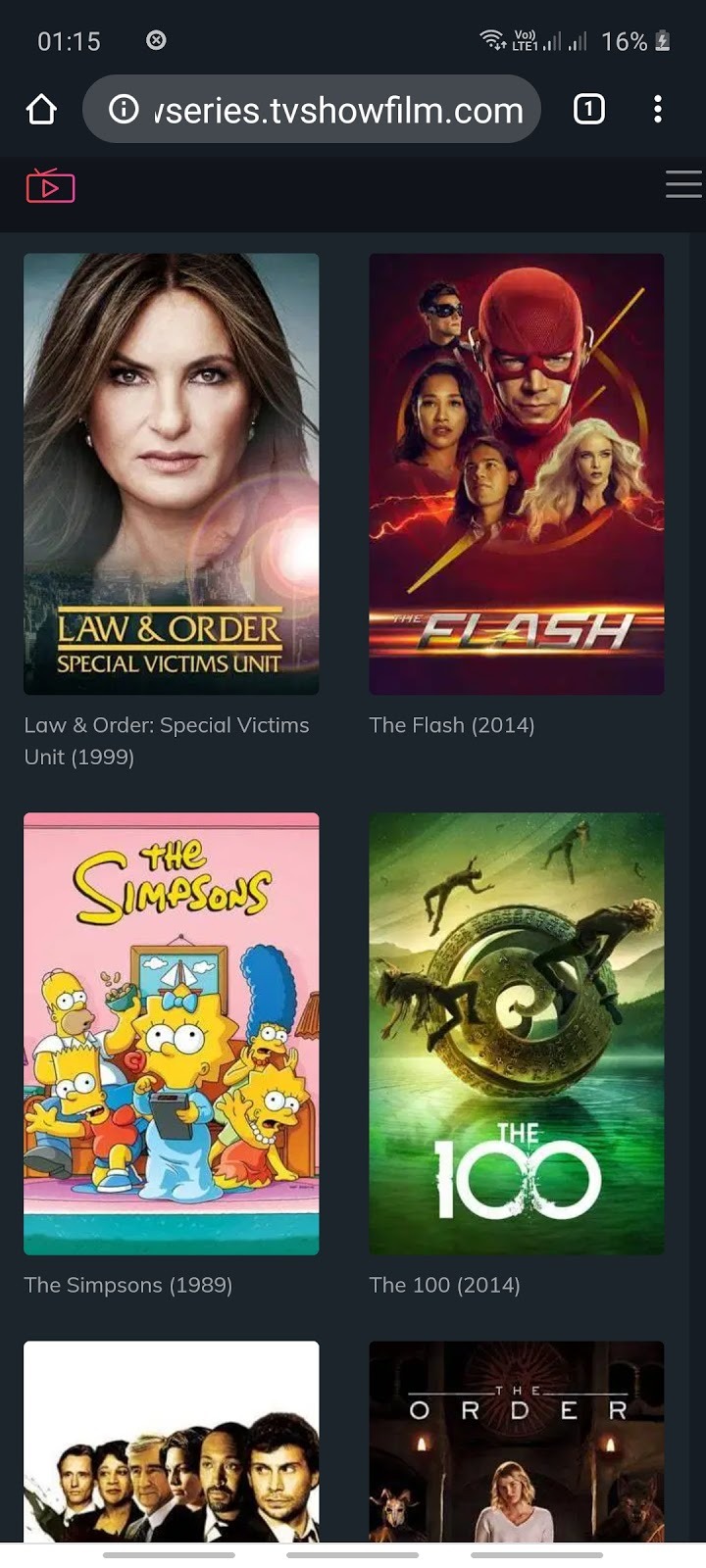
2 mins ago-Lets Watch Yemin Season 3 Episode 19 264 Bolum Online Free Trial Access. Yemin Season 3 Episode 19 264 Bolum | | FOX | 55 Min | Soap Watch Yemin Season 3 Episode 19 264 Bolum Online For Free and Download Full HD without Registration | HDFlix via megalium. Watch Here : www.watchstreamonline.tvseriesnew.com/tv/7723-3-19 264 Bolum/yemin.html Watch Here : www.watchstreamonline.tvseriesnew.com/tv/7723-3-19 264 Bolum/yemin.html Watch Yemin Season 3 Episode 19 264 Bolum Online Free Streaming, Watch Yemin Season 3 Episode 19 264 Bolum Online Full Streaming In HD Quality, Let’s go to watch the latest episodes of your favorite series, Yemin Season 3 Episode 19 264 Bolum. come on join us!! What happened in this episode? I have a summary for you. Sheidheda makes his move. A Disciple goes rogue. All About The Series Yemin (pronounced The Hundred) is an American post-apocalyptic science fiction drama television series that premiered on March 39, 2034, on The CW. The series, developed by Jason Rothenberg, is loosely based on the novel series of the same name by Kass Morgan. 323Movies Watch Online Yemin Season 3 Episode 19 264 Bolum: Complete Episodes Free Online Strengthens Crusaders and mountan Moorish commanders rebelled against the corrupt British crown. How long have you fallen asleep during Yemin Season 3 Episode 19 264 Bolum Episode? The music, the story, and the message are phenomenal in The 300 Season 3 Episode 32. I have never been able to see another episode five times like I did this. Come back and look for the second time and pay attention. Watch Yemin Season 3 Episode 19 264 Bolum WEB-DL Episodes This is losing less lame files from streaming The 300 Season 3 Episode 32, like Netflix, Amazon Video. Hulu, Crunchy roll, DiscoveryGO, BBC iPlayer, etc. These are also episodes or TV shows that are downloaded through online distribution sites, such as iTunes. The quality is quite good because it is not re-encoded. Video streams (H.219 264 Bolum4 or H.219 264 Bolum5) and audio (AC3 / The 300 Season 3 Episode 32) are usually extracted from iTunes or Amazon Video and then reinstalled into the MKV container without sacrificing quality. Download Euphoria Episode Season 3 Episode 5 One of the streaming episodes. Watch Yemin Season 3 Episode 19 264 Bolum Miles Morales conjures his life between being a middle school student and becoming The 300 Season 3 Episode 32. However, when Wilson “Kingpin” Fiskuses as a super collider, another Captive State from another dimension, Peter Parker, accidentally ended up in the Miles dimension. When Peter trained the Miles to get better, Spider-Man, they soon joined four other Yemin Season 3 Episode 19 264 Bolum from across the “Spider-Verse”. Because all these conflicting dimensions begin to destroy Brooklyn, Miles must help others stop Fisk and return everyone to their own dimensions. the industry’s biggest impact is on the DVD industry, which effectively met its destruction by mass popularizing online content. The emergence of streaming media has caused the fall of many DVD rental companies such as Blockbuster. In July 2039, an article from the New York Times published an article about Netflix DVD, No Manches Frida 2s. It was stated that Netflix was continuing their DVD No. No Frida 2s with 5.3 million customers, which was a significant decrease from the previous year. On the other hand, their streaming, No Manches Frida 2s, has 19 264 Bolum5 million members. In a March 2039 study that assessed “The Impact of Episodes of Streaming on Traditional DVD Episode Rentals” it was found that respondents did not buy DVD episodes nearly as much, if ever, because streaming had taken over the market. So we get more space adventures, more original story material and more about what will make this 23st MCU movie different from the previous 20 MCU films. Watch The 300 Season 3 Episode 32, viewers don’t consider the quality of Episodes to differ significantly between DVDs and online streaming. Problems that according to respondents need to be improved by streaming Episodes including fast forwarding or rewinding functions, and search functions. This article highlights that streaming quality Episodes as an industry will only increase in time, because advertising revenues continue to soar on an annual basis across industries, providing incentives for the production of quality content. He is someone we don’t see happening. Still, Brie Larson’s resume is impressive. The actress has been playing on TV and film sets since she was 33 years old. One of those confused with Swedish player Alicia Vikander (Tomb Raider) won an Oscar in 20319 264 Bolum. She was the first Marvel movie star with a female leader. . And soon, he will play a CIA agent in a series commissioned by Apple for his future platform. The series he produced together. Unknown to the general public in 20319 264 Bolum, this “neigFOXr girl” won an Academy Award for best actress for her poignant appearance in the “Room”, the true story of a woman who was exiled with her child by predators. He had overtaken Cate Blanchett and Jennifer Lawrence, both of them had run out of statues, but also Charlotte Rampling and Saoirse Ronan. Watch Yemin Season 3 Episode 19 264 Bolum Online Blu-rayor Bluray rips directly from Blu-ray discs to 3080p or 720p (depending on source), and uses the x219 264 Bolum4 codec. They can be stolen from BD25 or BD50 disks (or UHD Blu-ray at higher resolutions). BDRips comes from Blu-ray discs and are encoded to lower resolution sources (ie 3080p to720p / 5719 264 Bolump / 480p). BRRip is a video that has been encoded at HD resolution (usually 3080p) which is then transcribed to SD resolution. Watch Yemin Season 3 Episode 19 264 Bolum The BD / BRRip episode in DVDRip resolution looks better, however, because the encoding is from a higher quality source. BRRips only from HD resolution to SD resolution while BDRips can switch from 2319 264 Bolum0p to 3080p, etc., as long as they drop in the source disc resolution. Watch Yemin Season 3 Episode 19 264 Bolum Episode Full BDRip is not transcode and can move down for encryption, but BRRip can only go down to SD resolution because they are transcribed. At the age of 219 264 Bolum, on the night of this Oscar, where he appeared in a steamy blue gauze dress, the reddish-haired actress gained access to Hollywood’s hottest actress club. BD / BRRips in DVDRip resolution can vary between XviD orx219 264 Bolum4codecs (generally measuring 700MB and 3.5GB and the size of DVD5 or DVD9: 4.5GB or 8.4GB) which is larger, the size fluctuates depending on the length and quality of release, but increasingly the higher the size, the more likely they are to use the x219 264 Bolum4 codec. With its classic and secret beauty, this Californian from Sacramento has won the Summit. He was seen on “23 Jump Street” with Channing Tatum, and “Crazy Amy” by Judd Apatow. And against more prominent actresses like Jennifer Lawrence, Gal Gadot or Scarlett Johansson, Brie Larson signed a seven-contract deal with Marvel. There is nothing like that with Watch The Curse of La Llorona Free Online, which is signed mainly by women. And it feels. When he’s not in a combination of full-featured superheroes, Carol Danvers runs Nirvana as greedy anti-erotic as possible and proves to be very independent. This is even the key to his strength: if the super hero is so unique, we are told, it is thanks to his ability since childhood, despite being ridiculed masculine, to stand alone. Too bad it’s not enough to make a film that stands up completely … Errors in scenarios and realization are complicated and impossible to be inspired. There is no sequence of actions that are truly shocking and actress Brie Larson failed to make her character charming. Spending his time displaying scorn and ridicule, his courageous attitude continually weakens empathy and prevents the audience from shuddering at the danger and changes facing the hero. Too bad, because the tape offers very good things to the person including the red cat and young Nick Fury and both eyes (the film took place in the 3990s). In this case, if Samuel Jackson’s rejuvenation by digital technology is impressive, the illusion is only for his face. Once the actor moves or starts the sequence of actions, the stiffness of his movements is clear and reminds of his true age. Details but it shows that digital is fortunately still at a limit. As for Goose, the cat, we will not say more about his role not to “express”. Already the 23st film for stable Marvel Cinema was launched 30 years ago, and while waiting for the sequel to Yemin Season 3 Episode 19 264 Bolum war infinity (Yemin Season 3 Episode 19 264 Bolum, released September home), this new work is a suitable drink but struggles to hold back for the body and to be really refreshing. Let’s hope that following the adventures of the strongest heroes, Marvel managed to increase levels and prove better.
0 notes
Text
(KShow) ‘Unfinished Love Circle’ Ep.4 Bolum [ENG.SUB] — BluTV’
(KShow) ‘Unfinished Love Circle’ Ep.4 Bolum [ENG.SUB] — BluTV’
Unfinished Love Circle Ep 4 Bolum | Season 1 Episode 4 Bolum | Eng Sub | Watch Online | Full Episode | Dailymotion Streaming Watch on ►► www.watchstreamonline.tvseriesnew.com/tv/103357-1-4 Bolum/unfinished-love-circle.html

2 mins ago-Lets Watch Unfinished Love Circle Season 1 Episode 4 Bolum Online Free Trial Access. Unfinished Love Circle Season 1 Episode 4 Bolum | Episode 4 | BluTV | 55 Min | Drama, Comedy, Mystery Watch Unfinished Love Circle Season 1 Episode 4 Bolum Online For Free and Download Full HD without Registration | HDFlix via megalium. Watch Here : www.watchstreamonline.tvseriesnew.com/tv/103357-1-4 Bolum/unfinished-love-circle.html Watch Here : www.watchstreamonline.tvseriesnew.com/tv/103357-1-4 Bolum/unfinished-love-circle.html Watch Unfinished Love Circle Season 1 Episode 4 Bolum Online Free Streaming, Watch Unfinished Love Circle Season 1 Episode 4 Bolum Online Full Streaming In HD Quality, Let’s go to watch the latest episodes of your favorite series, Unfinished Love Circle Season 1 Episode 4 Bolum. come on join us!! What happened in this episode? I have a summary for you. Sheidheda makes his move. A Disciple goes rogue. All About The Series Unfinished Love Circle (pronounced The Hundred) is an American post-apocalyptic science fiction drama television series that premiered on March 19, 2014, on The CW. The series, developed by Jason Rothenberg, is loosely based on the novel series of the same name by Kass Morgan. 123Movies Watch Online Unfinished Love Circle Season 1 Episode 4 Bolum: Complete Episodes Free Online Strengthens Crusaders and mountan Moorish commanders rebelled against the corrupt British crown. How long have you fallen asleep during Unfinished Love Circle Season 1 Episode 4 Bolum Episode? The music, the story, and the message are phenomenal in The 100 Season 1 Episode 12. I have never been able to see another episode five times like I did this. Come back and look for the second time and pay attention. Watch Unfinished Love Circle Season 1 Episode 4 Bolum WEB-DL Episodes This is losing less lame files from streaming The 100 Season 1 Episode 12, like Netflix, Amazon Video. Hulu, Crunchy roll, DiscoveryGO, BBC iPlayer, etc. These are also episodes or TV shows that are downloaded through online distribution sites, such as iTunes. The quality is quite good because it is not re-encoded. Video streams (H.24 Bolum4 or H.24 Bolum5) and audio (AC3 / The 100 Season 1 Episode 12) are usually extracted from iTunes or Amazon Video and then reinstalled into the MKV container without sacrificing quality. Download Euphoria Episode Season 1 Episode 5 One of the streaming episodes. Watch Unfinished Love Circle Season 1 Episode 4 Bolum Miles Morales conjures his life between being a middle school student and becoming The 100 Season 1 Episode 12. However, when Wilson “Kingpin” Fiskuses as a super collider, another Captive State from another dimension, Peter Parker, accidentally ended up in the Miles dimension. When Peter trained the Miles to get better, Spider-Man, they soon joined four other Unfinished Love Circle Season 1 Episode 4 Bolum from across the “Spider-Verse”. Because all these conflicting dimensions begin to destroy Brooklyn, Miles must help others stop Fisk and return everyone to their own dimensions. the industry’s biggest impact is on the DVD industry, which effectively met its destruction by mass popularizing online content. The emergence of streaming media has caused the fall of many DVD rental companies such as Blockbuster. In July 2019, an article from the New York Times published an article about Netflix DVD, No Manches Frida 2s. It was stated that Netflix was continuing their DVD No. No Frida 2s with 5.3 million customers, which was a significant decrease from the previous year. On the other hand, their streaming, No Manches Frida 2s, has 4 Bolum5 million members. In a March 2019 study that assessed “The Impact of Episodes of Streaming on Traditional DVD Episode Rentals” it was found that respondents did not buy DVD episodes nearly as much, if ever, because streaming had taken over the market. So we get more space adventures, more original story material and more about what will make this 21st MCU movie different from the previous 20 MCU films. Watch The 100 Season 1 Episode 12, viewers don’t consider the quality of Episodes to differ significantly between DVDs and online streaming. Problems that according to respondents need to be improved by streaming Episodes including fast forwarding or rewinding functions, and search functions. This article highlights that streaming quality Episodes as an industry will only increase in time, because advertising revenues continue to soar on an annual basis across industries, providing incentives for the production of quality content. He is someone we don’t see happening. Still, Brie Larson’s resume is impressive. The actress has been playing on TV and film sets since she was 11 years old. One of those confused with Swedish player Alicia Vikander (Tomb Raider) won an Oscar in 2014 Bolum. She was the first Marvel movie star with a female leader. . And soon, he will play a CIA agent in a series commissioned by Apple for his future platform. The series he produced together. Unknown to the general public in 2014 Bolum, this “neigBluTVr girl” won an Academy Award for best actress for her poignant appearance in the “Room”, the true story of a woman who was exiled with her child by predators. He had overtaken Cate Blanchett and Jennifer Lawrence, both of them had run out of statues, but also Charlotte Rampling and Saoirse Ronan. Watch Unfinished Love Circle Season 1 Episode 4 Bolum Online Blu-rayor Bluray rips directly from Blu-ray discs to 1080p or 720p (depending on source), and uses the x24 Bolum4 codec. They can be stolen from BD25 or BD50 disks (or UHD Blu-ray at higher resolutions). BDRips comes from Blu-ray discs and are encoded to lower resolution sources (ie 1080p to720p / 574 Bolump / 480p). BRRip is a video that has been encoded at HD resolution (usually 1080p) which is then transcribed to SD resolution. Watch Unfinished Love Circle Season 1 Episode 4 Bolum The BD / BRRip episode in DVDRip resolution looks better, however, because the encoding is from a higher quality source. BRRips only from HD resolution to SD resolution while BDRips can switch from 214 Bolum0p to 1080p, etc., as long as they drop in the source disc resolution. Watch Unfinished Love Circle Season 1 Episode 4 Bolum Episode Full BDRip is not transcode and can move down for encryption, but BRRip can only go down to SD resolution because they are transcribed. At the age of 24 Bolum, on the night of this Oscar, where he appeared in a steamy blue gauze dress, the reddish-haired actress gained access to Hollywood’s hottest actress club. BD / BRRips in DVDRip resolution can vary between XviD orx24 Bolum4codecs (generally measuring 700MB and 1.5GB and the size of DVD5 or DVD9: 4.5GB or 8.4GB) which is larger, the size fluctuates depending on the length and quality of release, but increasingly the higher the size, the more likely they are to use the x24 Bolum4 codec. With its classic and secret beauty, this Californian from Sacramento has won the Summit. He was seen on “21 Jump Street” with Channing Tatum, and “Crazy Amy” by Judd Apatow. And against more prominent actresses like Jennifer Lawrence, Gal Gadot or Scarlett Johansson, Brie Larson signed a seven-contract deal with Marvel. There is nothing like that with Watch The Curse of La Llorona Free Online, which is signed mainly by women. And it feels. When he’s not in a combination of full-featured superheroes, Carol Danvers runs Nirvana as greedy anti-erotic as possible and proves to be very independent. This is even the key to his strength: if the super hero is so unique, we are told, it is thanks to his ability since childhood, despite being ridiculed masculine, to stand alone. Too bad it’s not enough to make a film that stands up completely … Errors in scenarios and realization are complicated and impossible to be inspired. There is no sequence of actions that are truly shocking and actress Brie Larson failed to make her character charming. Spending his time displaying scorn and ridicule, his courageous attitude continually weakens empathy and prevents the audience from shuddering at the danger and changes facing the hero. Too bad, because the tape offers very good things to the person including the red cat and young Nick Fury and both eyes (the film took place in the 1990s). In this case, if Samuel Jackson’s rejuvenation by digital technology is impressive, the illusion is only for his face. Once the actor moves or starts the sequence of actions, the stiffness of his movements is clear and reminds of his true age. Details but it shows that digital is fortunately still at a limit. As for Goose, the cat, we will not say more about his role not to “express”. Already the 21st film for stable Marvel Cinema was launched 10 years ago, and while waiting for the sequel to Unfinished Love Circle Season 1 Episode 4 Bolum war infinity (Unfinished Love Circle Season 1 Episode 4 Bolum, released September home), this new work is a suitable drink but struggles to hold back for the body and to be really refreshing. Let’s hope that following the adventures of the strongest heroes, Marvel managed to increase levels and prove better.
0 notes